Route 66 is more than just a road trip—it’s an iconic journey that captures the essence of American adventure and nostalgia. From the moment you hit the open road, you’re embarking on a voyage filled with unforgettable moments, vibrant vibes, and encounters with people who share your love for exploration!!
This legendary route, stretching from Chicago (in the state of Illinois) to Santa Monica (in Los Angeles, state of California), weaves through a tapestry of landscapes, towns, and attractions!! From the bustling streets of Chicago to the sun-kissed beaches of California, every km of Route 66 is steeped in history and charm. As you traverse this historic highway, you’ll encounter a treasure trove of sights and experiences that defy description. Whether it’s the towering skyscrapers of Chicago’s skyline, the neon-lit streets of small-town diners, or the breathtaking vistas of the Southwest, each stop along Route 66 holds its own unique allure. <3
But it’s not just about the destinations—it’s about the journey itself! Get ready for the adventure of a lifetime as Route 66 promises to be an unforgettable ride. Let the magic of the Mother Road unfold before you. The journey awaits!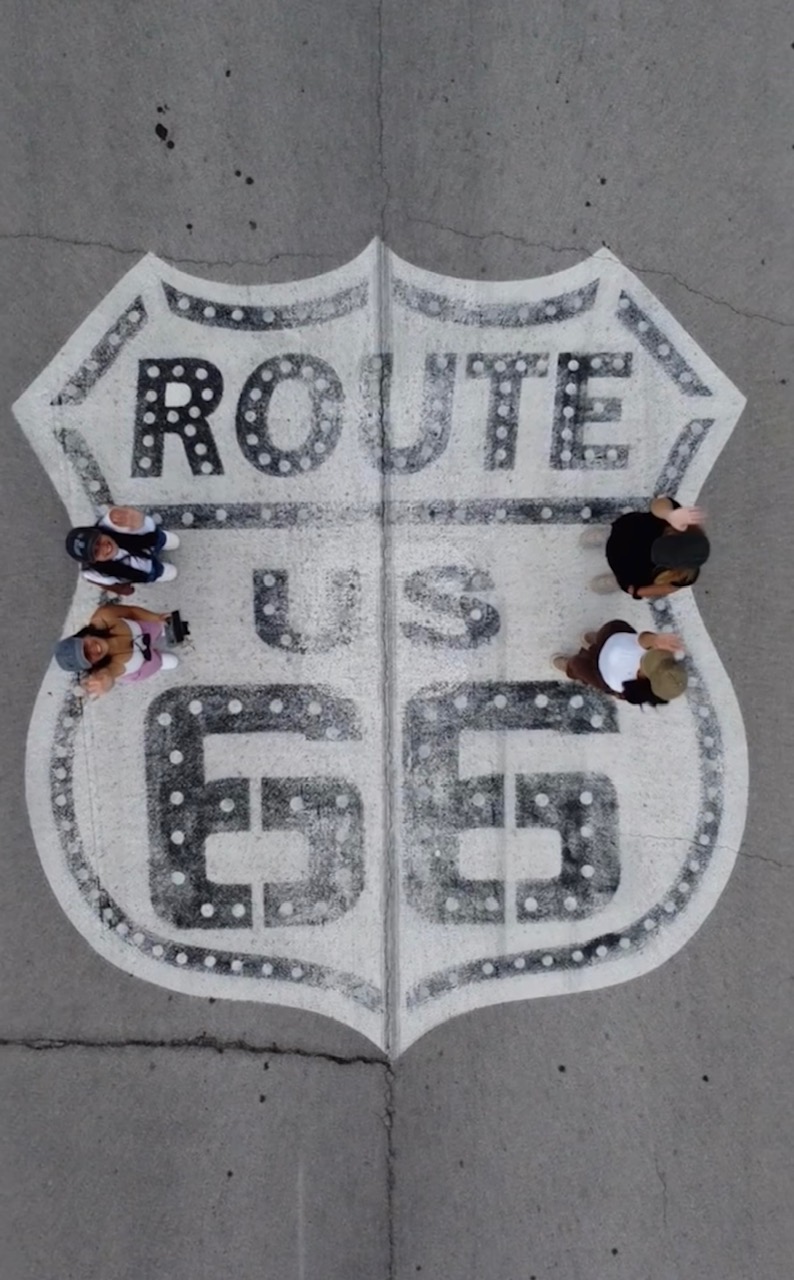
You have asked me so many things and details for this trip, so I will try to answer all of them through this blog post!
Let’s get started:
WHAS IS ACTUALLY THE ROUTE 66?
Route 66, also known as the “Main Street of America” is famous for its historical significance as one of the first highways in the U.S. stretching from Chicago, Illinois to Santa Monica in LA, California. It became iconic in American culture due to its role in migration, commerce, and tourism, especially during the mid-20th century.
WHEN WAS ROUTE 66 ESTABLISHED?
Route 66, also known as the “Mother Road,” was established on November 11, 1926, as one of the original highways in the U.S. Highway System. It was officially designated as U.S. Route 66, spanning from Chicago to Santa Monica. The creation of Route 66 was a significant development in American transportation history, providing a direct route for travelers and commerce between the Midwest and the West Coast. The highway played a vital role in the growth of communities along its route and became an iconic symbol of American mobility and freedom. Despite its decommissioning as a U.S. highway in 1985, Route 66 remains a beloved icon of American culture and continues to attract travelers from around the world who come to experience its historic motels, diners, roadside attractions, and the nostalgia of a bygone era in American travel!!!

East Adams Street in Chicago
WHICH AIRPORTS DID YOU USE?
I flew from my hometown and the Greek capital, Athens to Chicago in Illinois through Istanbul with Turkish Airlines and I returned from Los Angeles in California to Athens with same airline.
I booked the tickets on their site with the option “multi-city”.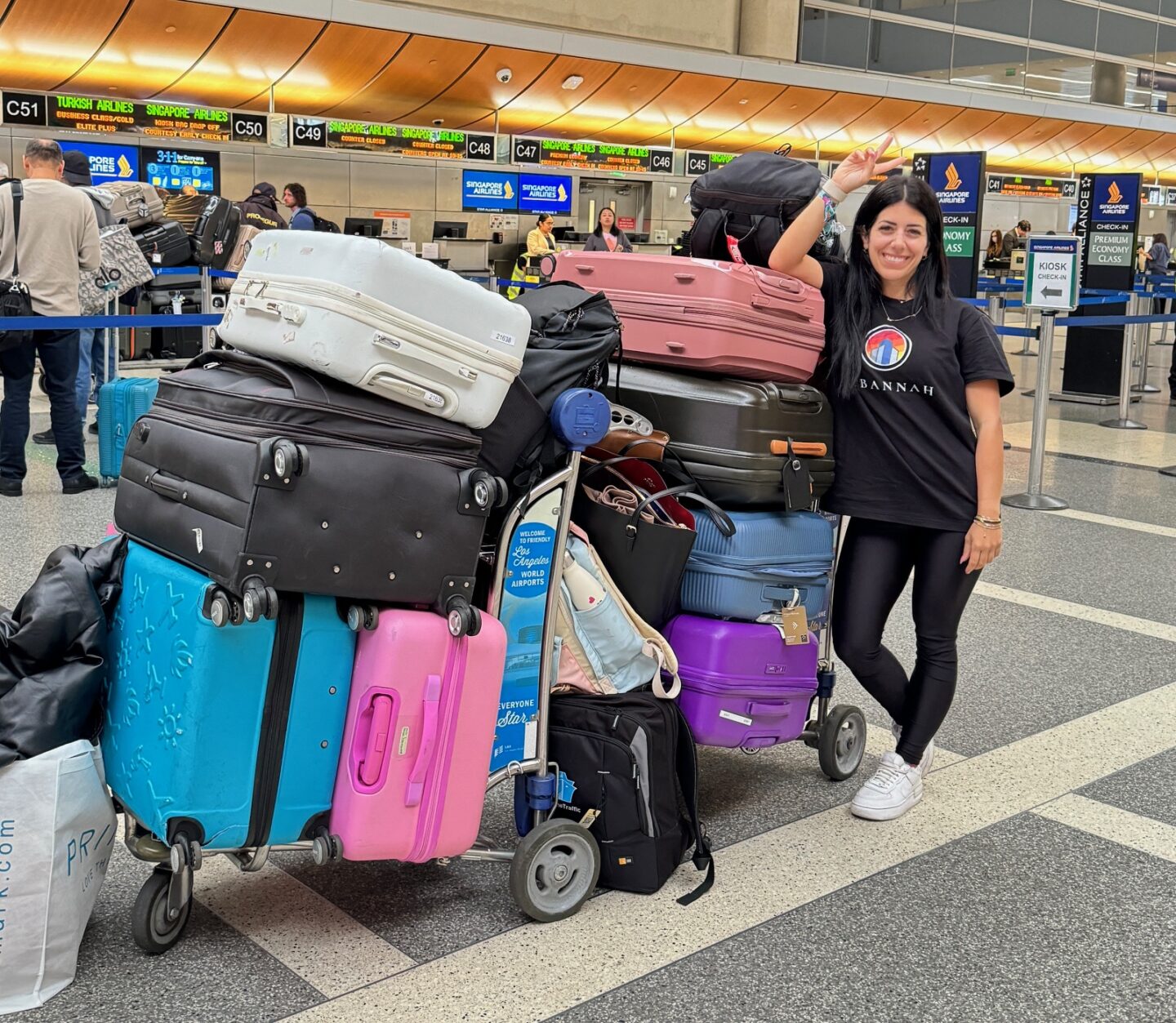
TIME ZONE?
Route 66 passes through multiple states, each of which may have different time zones. As a result, travelers driving along Route 66 may cross into 3 different time zones depending on their location along the route. For example:
- Illinois: In Illinois, Route 66 follows Central Time.
- Missouri: In Missouri, Route 66 also follows Central Time.
- Kansas: In Kansas, Route 66 follows Central Time.
- Oklahoma: In Oklahoma, Route 66 crosses into both Central Time and Mountain Time.
- Texas: In Texas, Route 66 follows Central Time.
- New Mexico: In New Mexico, Route 66 follows Mountain Time.
- Arizona: In Arizona, Route 66 follows Mountain Time, except for the Navajo Nation reservation in the northeastern part of the state, where Daylight Saving Time is not observed. In this area, Route 66 follows Mountain Standard Time (MST) during the winter months and Mountain Daylight Time (MDT) during the summer months.
- California: In California, Route 66 follows Pacific Time.
So: Chicago with Los Angeles have 2 hours difference!
DID YOU HAVE HEALTH INSURANCE?
Health insurance is important for several reasons, especially when traveling abroad:
- Medical Emergencies: Accidents and unexpected illnesses can happen at any time, even while on vacation. Having health insurance ensures that you have access to medical care without facing exorbitant out-of-pocket expenses.
- Coverage for Medical Expenses: Health insurance helps cover the cost of medical treatments, hospital stays, surgeries, prescription medications, and other necessary medical services. Without insurance, these expenses can quickly add up and potentially become financially burdensome.
- Peace of Mind: Knowing that you have health insurance coverage can provide peace of mind while traveling. You can focus on enjoying your trip without worrying about the financial implications of a medical emergency.
- Access to Quality Healthcare: With health insurance, you have access to a network of healthcare providers and facilities, ensuring that you receive quality medical care wherever you are traveling.
I’m fortunate to have private insurance through my job that covers emergencies while traveling abroad, so I didn’t need to seek additional coverage for this road trip. However, there are numerous companies online that specialize in travel insurance, offering peace of mind for a reasonable cost.
Angel’s tip: For this trip, the estimated cost for coverage was approximately 100 euros. Greek insurance companies like Anytime, Generali, or Interamerican are excellent options to consider when planning travels abroad. Their policies are tailored to meet the needs of travelers, ensuring you’re protected in case of unexpected events while exploring new destinations.
DID YOU HAVE INTERNET ON YOUR MOBILE?
If you’re traveling from Greece like me or another non-US country and you are planning to explore Route 66 in the USA, you will not be able to use your mobile data for free. You have though several options for accessing the internet:
- International Roaming: Check in advance with your mobile carrier to see if they offer international roaming plans for data usage in the USA. Be aware that international roaming can be expensive, so it’s essential to understand the rates and any data caps or limitations. Angel’s tip: For example with Vodafone in Greece, you can use your package as it is with cost 14-15 Euros per day.
- Public Wi-Fi: Many cafes, restaurants, hotels, and tourist attractions along Route 66 offer free Wi-Fi access. Sometimes even the car that you rent (you pay for it). Keep in mind that public Wi-Fi networks may not always be secure, so avoid accessing sensitive information while connected to them.
- Local SIM Card: Upon arrival in the USA, you can purchase a local SIM card from a mobile provider. This will give you access to data, calls, and texts within the USA. Make sure your phone is unlocked and compatible with the network frequencies used in the USA.
- eSIM(embedded SIM): Another option for accessing the internet while traveling to the USA and exploring Route 66. One example is JetPac Global but there are so many! Here’s how it works:
- Download the app & activate eSIM: Check if your mobile carrier supports eSIM technology and offers international data plans. If they do, you can activate an eSIM plan for your device before traveling.
- Data Plans: Choose a data plan that suits your needs, whether it’s a specific amount of data for a set duration or an unlimited data plan for the duration of your trip.
- Download eSIM Profile: Once you’ve activated your eSIM plan with your carrier, they will provide you with an eSIM profile, typically in the form of a QR code or a link. Follow the instructions provided by your carrier to download and install the eSIM profile onto your device.
- Usage: With the eSIM profile installed, you’ll have access to data services through your carrier while traveling in the USA. You can use the internet, make calls, and send texts according to the terms of your eSIM plan.
Using an eSIM offers the convenience of activating a data plan remotely without needing a physical SIM card. But it is a bit more expensive than the physical card.
IS ROUTE 66 STILL DRIVABLE?
Yes, although it was decommissioned as a U.S. highway in 1985, much of the original route is still accessible and drivable, albeit with some parts now replaced by modern interstates. An incedible road with amazing moments!!
Angel’s tip: Sometimes it is not easy to find Route 66, I totally recommend you to download an app called “Route 66 Navigation”, as we did. Not only does it guide you correctly but it also provides many info, photos and tips as well.
HOW MANY KM DO YOU DRIVE?

HOW MANY DAYS DO YOU NEED?
You can just do the Route 66 in 18-20 days but in case you want to add some extra things like we did, you need at least 3 weeks. Deviations include the Grand Canyon, the Antelope Canyon, Sedona, Las Vegas and many more…
Our trip was 23 days and ideally we could have used at least one more week.
Angel’s tip: Plan your trip well in advance with details, book whatever it is needed and take your time to enjoy the sights and experiences along the way. But have in mind that you have to drive a lot in order to cover all this distance. It is quite tiring sometimes…
A short and ideal itinerary for you, in my opinion: (ideal for me in order to experience it to the fullest is 3-4 weeks but I understand this is not easy)
- 2 nights in Chicago in Illinois
- 1 night in Springfield in Missouri (Angel’s tip: Start early am from Chicago, so you may need to rent your car/Rv from the previous night)
- 1 night in Tulsa in Oklahoma
- 1 night in Amarillo in Texas
- 1 night in Albuquerque in New Mexico
- 2 nights in Flagstaff in Arizona
- 2 nights in Grand Canyon village or in Williams town, 1 hour drive far. Angel’s tip: Due to the distances and the expensive accommodation in the village, I am not sure if I recommend you to stay in there, as we did. A great alternative that we liked more at the end, was Williams town. A charming small town on Route 66 that serves as a gateway to the Grand Canyon!
- 2-3 nights in Las Vegas in Nevada (we had 2 and we wanted more)
- 4-5 nights in Los Angeles in California
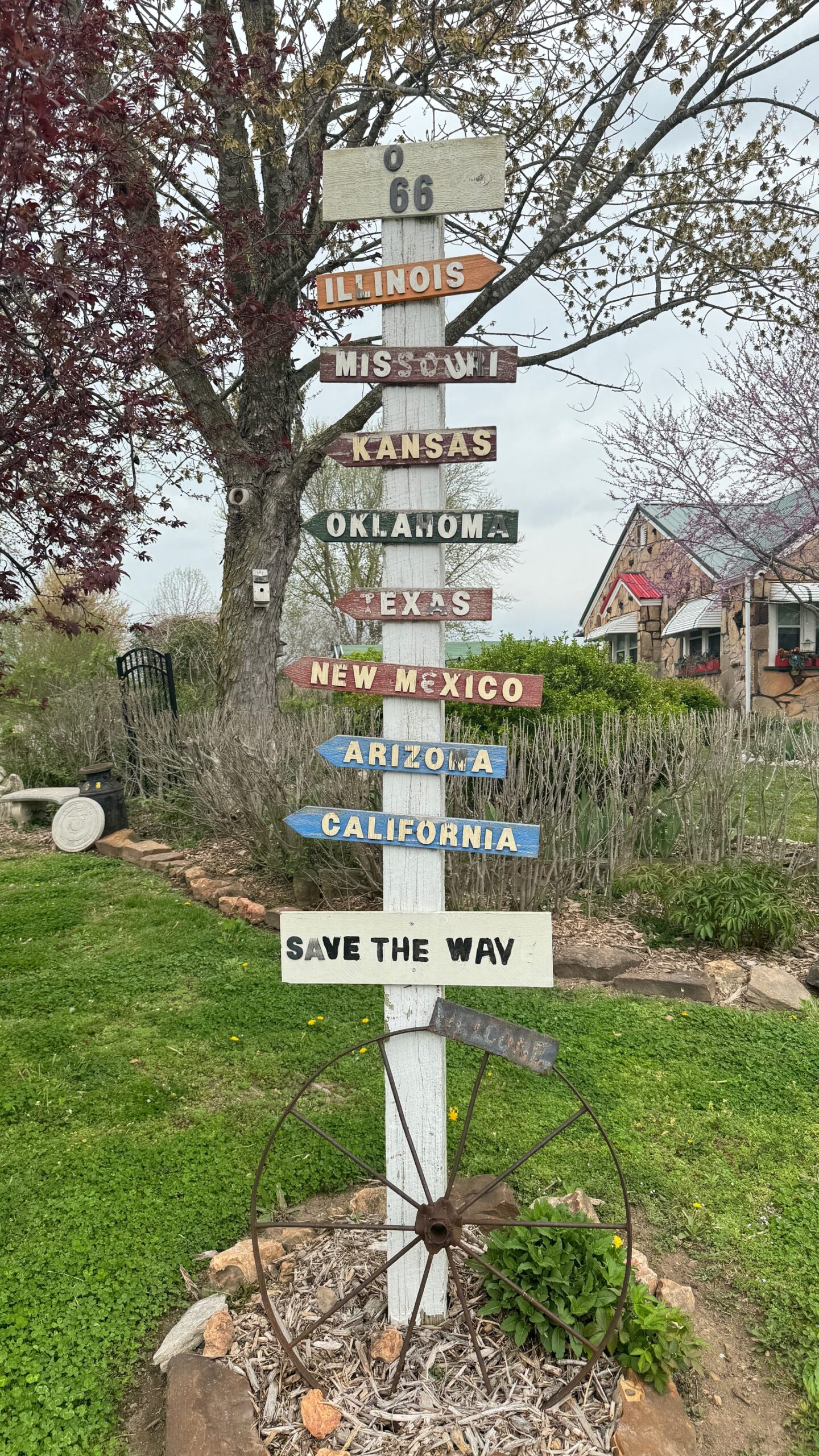
Angel’s tip: We added 1 night in Palm Springs to see it & stroll around Joshua tree (it was nice!) and 3 nights in Indio for the Coachella music festival. We spent also 1 night in San Diego in a friend’s house, and although San Diego is wonderful, you can skip it if you are in a hurry and go straight to Los Angeles to finish the Route 66!
Angel’s tip:If you don’t visit Las Vegas at all, after Grand Canyon, you can spend a night in Needles and then head towards Los Angeles.
Angel’s tip: If you do visit Las Vegas, you have time to spare and you don’t want to miss any part of Route 66, on the way back, drive from Las Vegas to Kingman and from there to Santa Monica in LA.
WHAT IS THE BEST TIME OF THE YEAR?
All year long but ideally avoid winter due to the unpredictable weather conditions. We were there during April and we came across all kind of weather conditions, from tornado and snow to heatwave. Angel’s tip: We chose the specific dates because we wanted to attend Coachella, one of the most famous music festivals in the world. Coachella took place the 3rd weekend we were there.
Read more for my Coachella experience in my other blog post here.
HOW MANY DAYS DO YOU NEED IN THE BIG CITIES?
To begin with, you need 3 days in Chicago, at least 4-5 days in Los Angeles and 3-4 days in Las Vegas.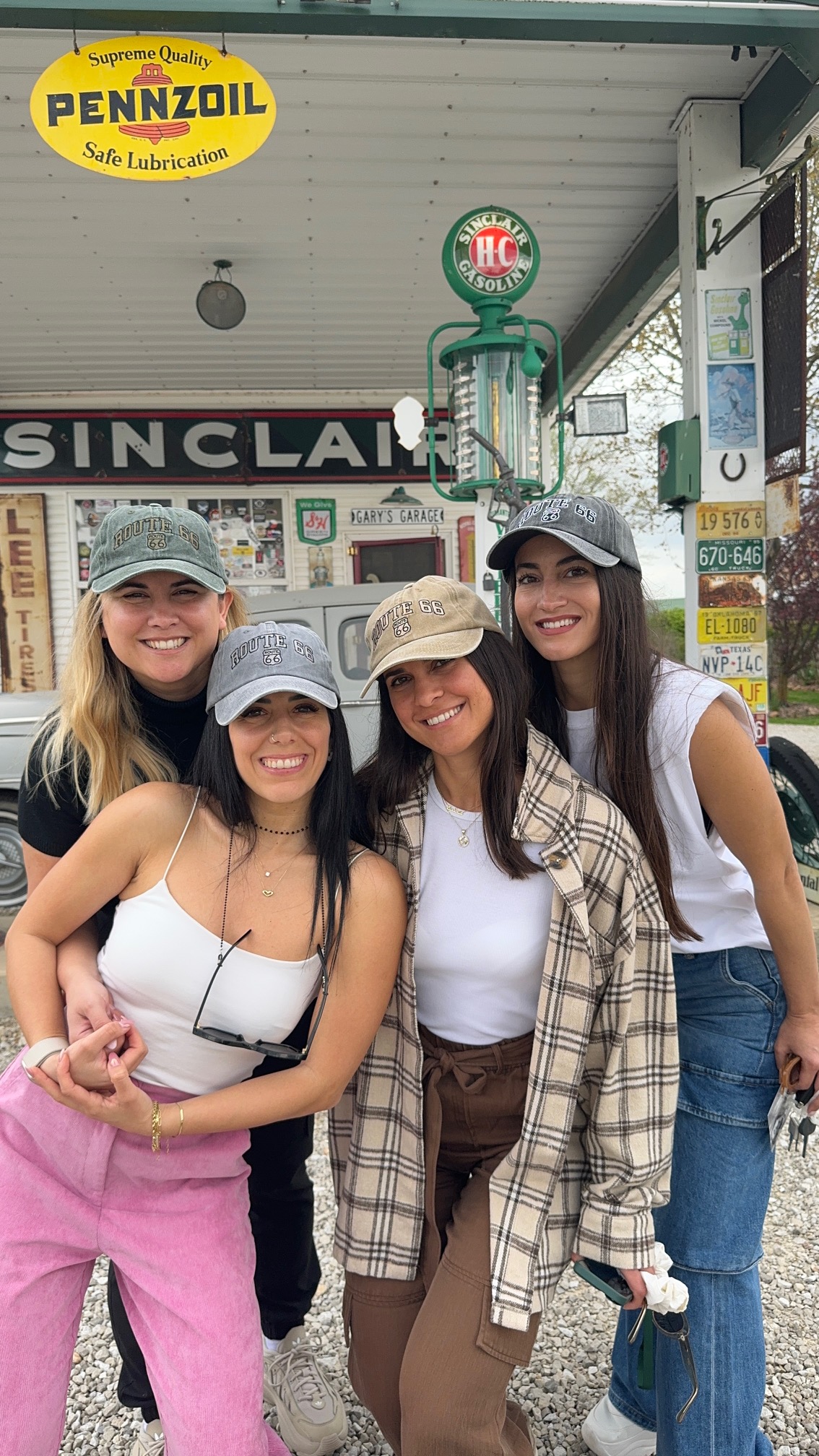
ARE THERE ANY FAMOUS THINGS TO SEE ALONG ROUTE 66?
Absolutely! There are many iconic diners and cafes, such as the Midpoint Cafe in Adrian,Texas or the Rock Cafe in Oklahoma to many historic gas stations and motels, iconic art installations or ghost towns offering travelers a nostalgic experience. Examples include the Blue Swallow Motel in New Mexico,the Wigwam Motel in Arizona or the Cadillac Ranch in Texas.
I will write them thoroughly below. Angel’s tip: Check my highlights on Instagram for more pics & details.
ANY MUST EAT FOOD DURING THE ROUTE 66?
Route 66 offers a diverse culinary journey with plenty of must-try foods along the way. Here are some iconic dishes and food experiences to enjoy as you travel along Route 66:
- Steak at a Historic Steakhouse: Indulge in a hearty steak dinner at one of the historic steakhouses along Route 66, such as The Big Texan Steak Ranch in Amarillo, Texas, where you can attempt their famous 72-ounce steak challenge.

- Burgers and Diners: Route 66 is dotted with classic diners and burger joints serving up delicious burgers. Do it like the Americans, with a milkshake – classic!

- Barbecue: Feast on mouthwatering barbecue ribs, brisket, and pulled pork at barbecue joints along Route 66, particularly in the states like Texas, Oklahoma, and Missouri, where barbecue traditions run deep.
- Tex-Mex Cuisine: Enjoy Tex-Mex specialties like tacos, enchiladas, and fajitas at restaurants along Route 66, especially in Texas and New Mexico.

- Route 66 Soda Pop Shops: Quench your thirst with unique and nostalgic sodas from Route 66-themed soda pop shops, where you can find a wide variety of craft sodas and vintage favorites.

- Diner Breakfasts: Start your day with a classic diner breakfast featuring eggs, bacon, pancakes, and hash browns (my favorite with eggs as per the picture below!) served with bottomless coffee at a roadside diner.

Ye Olde Pancake Station
- Fried Chicken: Crispy fried chicken is a comfort food favorite that you can find at diners, roadside restaurants, and fast-food joints along Route 66.

- Snow cone: shaved ice topped with flavored syrup ! Snow cones are not only delicious but also a nostalgic treat that adds to the fun and charm of traveling along Route 66. So be sure to keep an eye out for snow cone stands and treat yourself to this classic roadside delight during your journey!
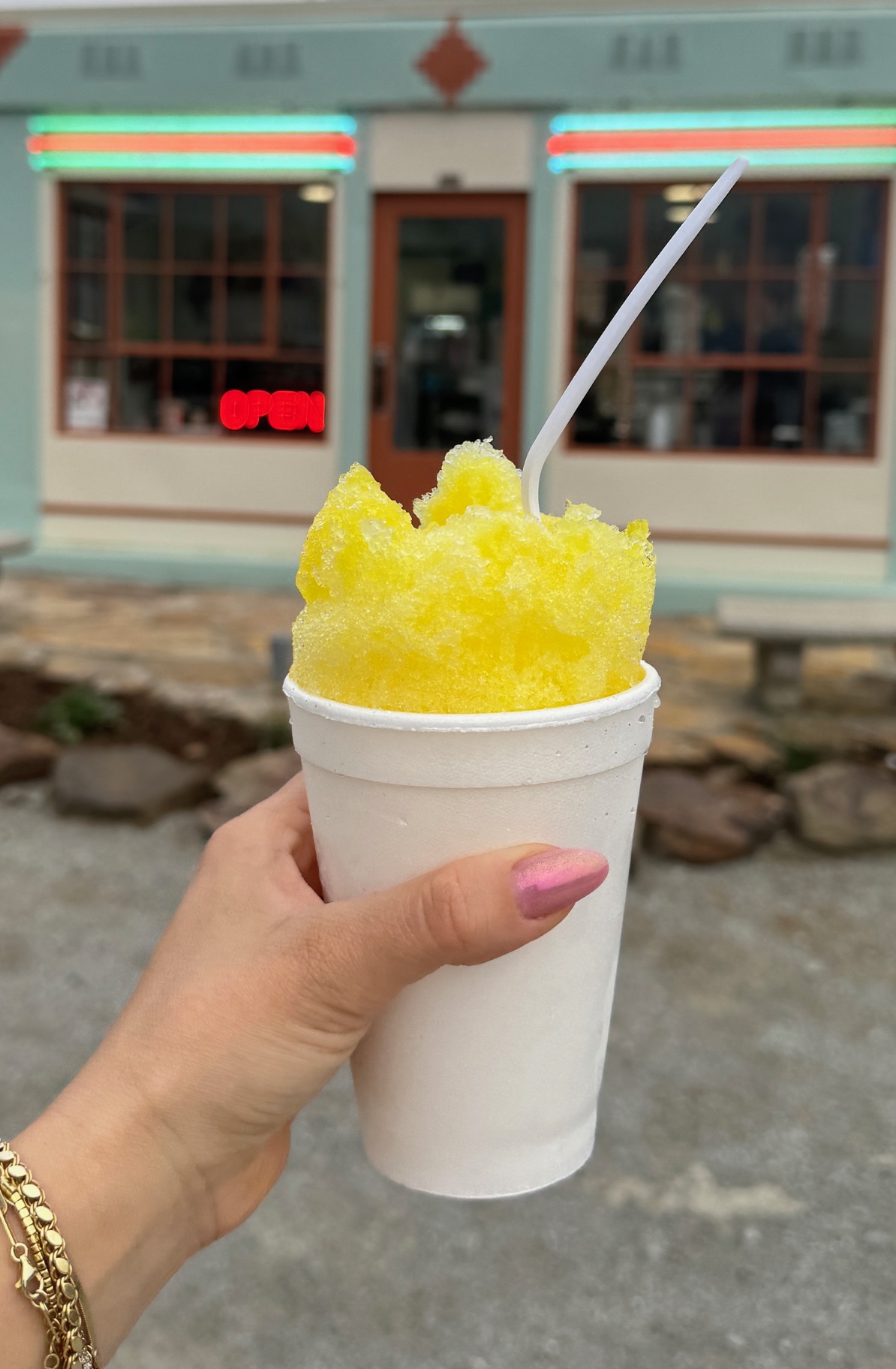
- Local Specialties: Don’t forget to try local specialties and regional dishes unique to the areas you pass through along Route 66. Ask locals for recommendations to discover hidden gems and authentic flavors. An example is this one: Soda with Ice cream that we met in Lottie’s soda shop in Missouri!

IS IT BETTER TO RENT A CAR OR RV?
To begin with, RV means Recreational Vehicle or a motor vehicle equipped with living space, bathroom, shower and amenities found in a home. So you can shower in it and stay inside during the night! RVs are often used for camping, vacations, and road trips. Angel’s tip: We rented both during the whole trip and it was the best thing we could do despite the fact that RV is indeed more difficult!! IT WAS JUST AN INCREDIBLE experience and I am not a camping person. So, I totally recommend you doing the same – both!
What did we do? We started from Chicago with an RV that we rented from the company “Indie campers” and we switched to a car in Phoenix, Arizona. Angel’s tip: The initial plan was to switch the RV with a car in Las Vegas but we couldn’t find any empty RV spot in the next RV park we had plans to stay for 2 nights. That’s why we chose Phoenix city that was a deviation (tiring!) but it was not possible in any other town/city.
Let’s check the pros and cons list of renting an RV:
(+)Pros:
- Accommodations on wheels: With an RV, you have the convenience of bringing your accommodations with you wherever you go. You can sleep, cook, and relax in the comfort of your own space.
- Cost savings: While upfront costs for renting or owning an RV can be high, you can save money on accommodation and dining expenses by cooking your meals and staying in campgrounds instead of hotels.
- Flexibility: With an RV, you have the flexibility to change your itinerary and explore off-the-beaten-path destinations without worrying about finding lodging. With a car, you’ll need to plan your itinerary more carefully and book accommodations in advance, as last-minute lodging options may be limited, especially in remote areas along Route 66.
- Comfort: RVs typically offer more space and amenities than cars, including bathroom, kitchen, and living area, making long drives more comfortable. Angel’s tip: After RV, we rented a 7 seats Chevrolet Suburban, as you can see below, to have enough space for our 10 suitcases . The best decision we could make!
(-)Cons:
- Size and maneuverability: RVs are larger and bulkier than cars, making them more challenging to maneuver in urban areas and tight spaces. With cars, parking is much easier obviously!
- Fuel costs: RVs consume more fuel than cars, which can result in higher fuel expenses, especially on long road trips like Route 66.
- Limited parking options: Finding parking for an RV, especially in urban areas or popular tourist destinations, can be challenging and may require advance planning. We met some parkings for example in Sedona or Santa Fe that don’t allow RVs to park.
- Maintenance and upkeep: RVs require regular maintenance and upkeep, including emptying waste tanks, refilling water supplies, and servicing mechanical systems.
- Speed: RVs are slower than cars and more difficult when you have to face wind. Angel’s tip: Have in mind that GPS shows you the highway option, so with Route 66 and RV, the time was almost double! For example, while GPS was showing us a distance of 2 hours, for us it was 3.5 hours!

CAN YOU RENT THE RV WITH A DRIVING LICENSE?
Yes, you can rent an RV with a regular car driver’s license (often referred to as a Type B license in some countries). This typically allows you to drive vehicles with a maximum authorized mass (MAM) of up to 3.5 metric tons (approximately 7,716 pounds), like the RV we rented.
Driving an RV, especially a larger one, can be different from driving a car and may require some adjustment though. Before embarking on your trip, it’s a good idea to familiarize yourself with the RV’s controls, handling characteristics, and safety features. Angel’s tip: While it’s not mandatory to convert your Greek driver’s license for use in the United States, having an International Driving Permit can provide added convenience and peace of mind during your visit and any potential traffic stops along the road. We did it (60€ each in Greece). 
RV SHOWS MILES OR KM?
RVs typically display mileage in miles, especially in countries like the United States where the imperial system is used. However, some RVs have both options, like the one we rented!
CAN I PARK MY RV ANYWHERE?
In general, aside from Sedona, where finding suitable parking for an RV can be a bit tricky due to limited spaces, we didn’t encounter significant challenges with parking along Route 66. The roads in the USA are typically spacious and wide, making it easier to find parking, even outside the places we wanted to visit. However, it’s important to be mindful of property ownership and local regulations. Route 66 passes through various cities, towns, and jurisdictions, each with its own rules regarding parking and camping. So, while parking may not be a major issue overall, it’s essential to understand and respect the rules of each area along the route.
Angel’s tip: I saw many RVs at night along the way in the parkings of supermarkets or public parking areas. Despite that, in my opinion the safer and better option is to choose RV Parks.
An RV park, also known as a recreational vehicle park or campground, is a designated area where individuals with RVs can park and stay overnight or for an extended period of time. These parks typically provide various amenities and facilities tailored to the needs of RV travelers like hookups for electricity, water, and sewage disposal where RVs can park. Other amenities such as restrooms, showers, laundry facilities, and sometimes recreational facilities like swimming pools or playgrounds. Sometimes you can have Wi-Fi internet access and connectivity options for guests as well. Angel’s tip: Our RV, which was 11 feet tall, didn’t have any problems with bridges or finding parking on Route 66. Just make sure to check signs for weight limits and height restrictions to avoid any issues along the way!
WHICH RV PARKS DID YOU USE?
Along Route 66, you’ll find numerous RV parks and campgrounds catering to travelers exploring the historic route. These RV parks offer a range of amenities and accommodations to suit different preferences and budgets. Angel’s tip: Most of the RV parks we chose had a cost of $40-$60 per night and all of them had showers and bathroom facilities, be careful to book parks that have such.
The ones we booked:
- Cooks RV Motor Park in Springfield in Missouri
- Honcho RV Park in Tulsa in Oklahoma
- The Big Texan RV Runch in Amarillo in Texas
- Enchanted trails RV Park & Trading Post in Albuquerque in New Mexico
- Black Barts RV Park in Flagstaff in Arizona (we had booked this one but bathrooms were not working and weather conditions were bad (it was snowing a lot) so we canceled it when we were already there and booked a cheap hotel instead)
Angel’s tip: After Texas, in Tucumcari in New Mexico we stayed in a historic motel instead of an RV Park along the Route 66. It was just awesome and we parked for free our RV outside. The name is “Blue Swallow Motel”. Our stay was like living in a classic movie! The vintage charm, from the iconic neon sign to the retro furnishings, transported us back in time. The hospitality was incredible too. One night wasn’t enough – we’ll definitely be back for more and I totally recommend it!
Angel’s tip: If you want to stay in an RV Park in Tucumcari, you can choose the Blaze-in-Saddle RV Park.
Angel’s tip: If you plan to park your RV in Grand Canyon Village, make sure to book way ahead! Spots fill up fast, so it’s smart to reserve months in advance (even 6 months!).We switched from our RV to a car because when we tried booking a month earlier, everything was already full. It’s better to plan ahead to avoid missing out on a spot. You can have a look and check availability here.
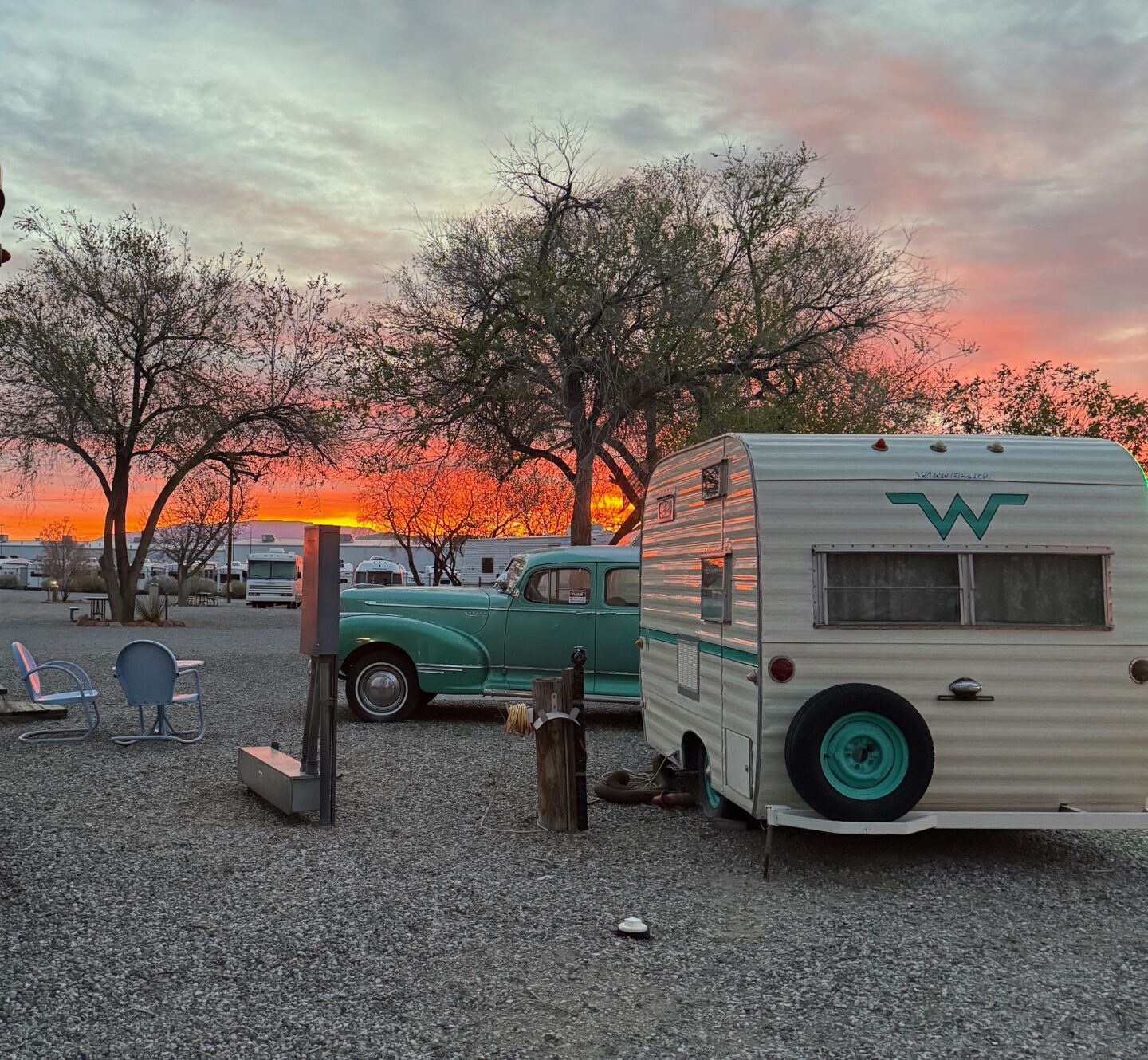
Enchanted trails RV Park
USEFUL THINGS TO HAVE WITH YOU
- Travel Documents: Ensure you have your passport, visa (if required), travel insurance information, driver’s license, and any other necessary documents. Angel’s tip: Visa is not required for Greek nationals visiting USA but you must apply for an ESTA 2-3 weeks before you arrive in US. Cost is $20 and you can apply here.
- Currency: Bring some US dollars in cash with you for safety or some immediate expenses upon arrival. If you don’t have, no worries as they use credit cards everywhere. Angel’s tip: Have in mind that we needed some cash in the casinos of Las Vegas.
- Power strip(cord): it was soooo useful for us, especially when we had to charge on the same time mobiles, drones, power banks, apple watches etc! Angel’s tip: Don’t forget it!!
- Travel Adapter: Bring a universal travel adapter to charge your electronic devices and plug them into different types of outlets.
- Portable Power Bank: Keep your devices charged while on the go with a portable power bank.
- Travel Guidebook: Consider bringing a travel guidebook or downloading travel apps for information about attractions, restaurants, accommodations, and local tips along Route 66 and in other areas you plan to visit. Otherwise just print this guide and have it with you!
- Reusable Water Bottle: Stay hydrated while traveling by bringing a reusable water bottle. You can refill it at water fountains or restaurants to save money and reduce plastic waste.
- Comfortable Clothing and Shoes: Pack comfortable clothing and footwear suitable for walking, hiking(in Santa Fe or Grand Canyon for example) and exploring outdoor attractions. I had one pair of night shoes for Las Vegas, LA & Chicago and flip flops. Layers are useful for adapting to changing weather conditions as you will face most probably much difference between the states, as I did.
- Sun Protection: Bring sunscreen, sunglasses, and a hat to protect yourself from the sun, especially if you’ll be spending time outdoors. The sun in the USA can be strong, particularly in desert regions. Angel’s tip: You can buy of course great Route 66 or LA hats when you are there!
- First Aid Kit: Pack a basic first aid kit with essentials such as bandages, pain relievers, Antihistamines, Imodium, antiseptic wipes, and any personal medications you may need.
- Snacks and Water: Keep snacks and water handy, especially during long drives or when exploring remote areas where food options may be limited.

IS ROUTE 66 SAFE TO TRAVEL ALONE?
Generally, Route 66 is considered safe for solo travellers, but it’s always wise to exercise caution, especially in remote areas, and to let someone know your itinerary. However, it’s more fun during the long drives and different attractions to have someone to share these moments with! Angel’s Tip: I totally recommend spending the nights in RV parks.
WHAT WAS YOUR FAVORITE PLACE?
The most difficult question you did to me and I do not have an answer! Choosing the “best” place along Route 66 can depend on personal preferences and interests, as the route spans diverse landscapes and offers a variety of unique attractions, so the best place for me can be different than yours. I really cannot choose as I ABSOLUTELY LOVED every day! From Chicago city to small towns along the way, the motels and the gas stations we met, the canyons we explored, the deviations we made like Las Vegas or Sedona and of course Santa Monica in Los Angeles – the ending point. Sorry but I don’t have a favourite place! The entire Route 66 was like a movie and a dream for us!

WHAT WAS YOUR ITINERARY?
Let me speak separately for each state & places Route 66 passes through and where we stopped:
1st state: ILLINOIS
The starting point of Route 66, Chicago offers vibrant neighborhoods, cultural attractions, and iconic landmarks such as Millennium Park and Navy Pier. I have an entire article for Chicago, click here to read more.
Route 66 in Illinois traverses diverse landscapes, including farmlands, rolling hills, and forests. Take your time to enjoy the scenic beauty of the Illinois countryside as you drive along the historic route.
Angel’s tip: We devoted 3 days in Chicago and we rented the RV here on our last day (from the company Indie Campers) so I recommend you doing the same. Otherwise you rent a car either when you reach Chicago or a few hours before leaving the city.
Capital: Springfield
Sightseeings:
- Chicago city (check my relevent article here)
- Gemini Giant statue in Wilmington
- Route 66 Hall of Fame and Museum in Pontiac
- Ryburn Place Gifts & Gab in Normal
- Lincoln Home National Historic Site, the Abraham Lincoln Presidential Library and Museum, and the Old State Capitol State Historic Site in Springfield
- Litchfield Museum & Route 66 Welcome Center
- Litchfield, Carlinville, and Edwardsville towns
Food stops: Docs Just Off 66 in Girard, Cozy Dog Drive In for corn dogs in Springfield , The Twistee Treat diner at the Pink Elephant in Livingston (before St Louis)
Our accommodation in: Hyatt Centric The Loop for 2 nights in Chicago
Historic motels on the state: Route 66 Hotel & Conference Center in Springfield
2nd state: MISSOURI
Capital: Jefferson City
Sightseeings:
- St Louis city with the iconic Gateway Arch (tallest arch in the world), the historic Soulard neighborhood, and the Delmar Loop, a vibrant entertainment district with shops, restaurants, and live music venues.

- The Route 66 State Park in Eureka, if you have time for hiking and exploring the park.
- Meramec Caverns near Stanton, as it is a popular tourist attraction along Route 66. You can take a guided tour of the caverns to see stunning rock formations, underground rivers, and historical artifacts.
- World’s Largest Rocking Chair on Historic Route 66 in Fanning
- The Route 66 Museum Complex in Lebanon
- Springfield, Rolla, and Carthage towns to feel the vibes and explore historic downtown districts, local shops, and diners.
- Gary’s Gay Parita Gas station & souvenir shop at Paris Junction. Angel’s tip: A huge painting of Route 66 on the road outside the gas station.
- Red Oak II, an open air museum of a bygone era. No entrance fee.

Food stops: Munger Moss Motel in Lebanon, the Wagon Wheel Cafe in Cuba. Black Sheep Burgers and Shakes in Springfield for gourmet burgers, Supertam On 66 Ice Cream Parlor for ice cream, Lottie’s Soda Shoppe in Reeds for ice cream, snacks & sodas
Our accommodation in: Cooks RV Motor Park in Springfield
Historic motels on the state: Wagon Wheel Motel in Cuba, Munger Moss Motel in Lebanon, Boots Court Motel in Carthage
3rd state: KANSAS
While Kansas has a relatively short stretch of Route 66, there are still several attractions and points of interest worth exploring along the route.
Capital: Topeca
Sightseeings:
- Baxter Springs Heritage Center and Museum in Baxter Springs where you can learn about the area’s mining heritage, Native American history, and Route 66 artifacts.
- Rainbow Bridge near Riverton built in 1923, one of the last remaining Marsh Arch bridges along Route 66.
- Galena town where you can see the “Cars on the Route” attraction. There you can see the original tow truck that inspired the character “Tow Mater” in the Disney movie “Cars.”
- Kan-O-Tex Service Station in Galena, a restored 1934 filling station that once served travelers along Route 66. Today, it serves as a visitor center and a glimpse into the history of the Mother Road.
- Visit the Old Riverton Store in Riverton, a historic general store that has been serving travelers since 1920s and it is famous for its sandwiches. Today, it offers a nostalgic shopping experience and a glimpse into the past of Route 66 with great souvenirs!
Food stops: Route 66 Cafe in Galena and the Old Riverton Store in Riverton for sandwiches
Accommodation: no
Historic motels on the state: The Little Brick Inn in Galena
4th state: OKLAHOMA
Whether you’re interested in history, natural beauty, or local culture, Oklahoma has something to offer every traveler exploring the Mother Road.
Capital: Oklahoma City

St Joseph Old Cathedral in Oklahoma city
Sightseeings :
- Ribbon Road near Miami
- Blue Whale on a lake near Catoosa (most impressive during night)

- Tulsa town with many things like the historic Cyrus Avery Route 66 Memorial Bridge,the Blue Dome District and the Golden Driller Statue.
- Buck Atom’s Cosmic Curios on 66 for souvenirs in Tulsa.
- Oklahoma Route 66 Museum near Clinton that offers interactive exhibits and displays that chronicle the history of Route 66 in Oklahoma.
- Small towns like Claremore, Chandler, and Elk City to explore historic downtown districts, museums, and landmarks.
- Miami, Sapulpa, and El Reno towns with the wonderful murals.
- Oklahoma City where, if you have time, you can make a stop and visit its museums like the National Cowboy & Western Heritage Museum and the Oklahoma City National Memorial & Museum. Explore Bricktown which is a vibrant entertainment district located in downtown Oklahoma City, visit the Oklahoma State Capitol building, ride the Wheeler Ferris Wheel with panoramic views of the city skyline and the riverfront area and experience the Old West atmosphere of Stockyards City, a historic district known for its cattle markets, Western wear shops, and cowboy culture.
Food stops: Tally’s cafe in Tulsa (loved it), Rock Cafe in Stroud as a Route 66 roadside attraction, Waylan’s Ku-Ku Burger in Miami town, Pops 66: a landmark diner & gas station with hundreds of sodas, a shop & a 66-ft.-tall soda bottle out front, Sid’s Diner in El Reno town(sooo cute)
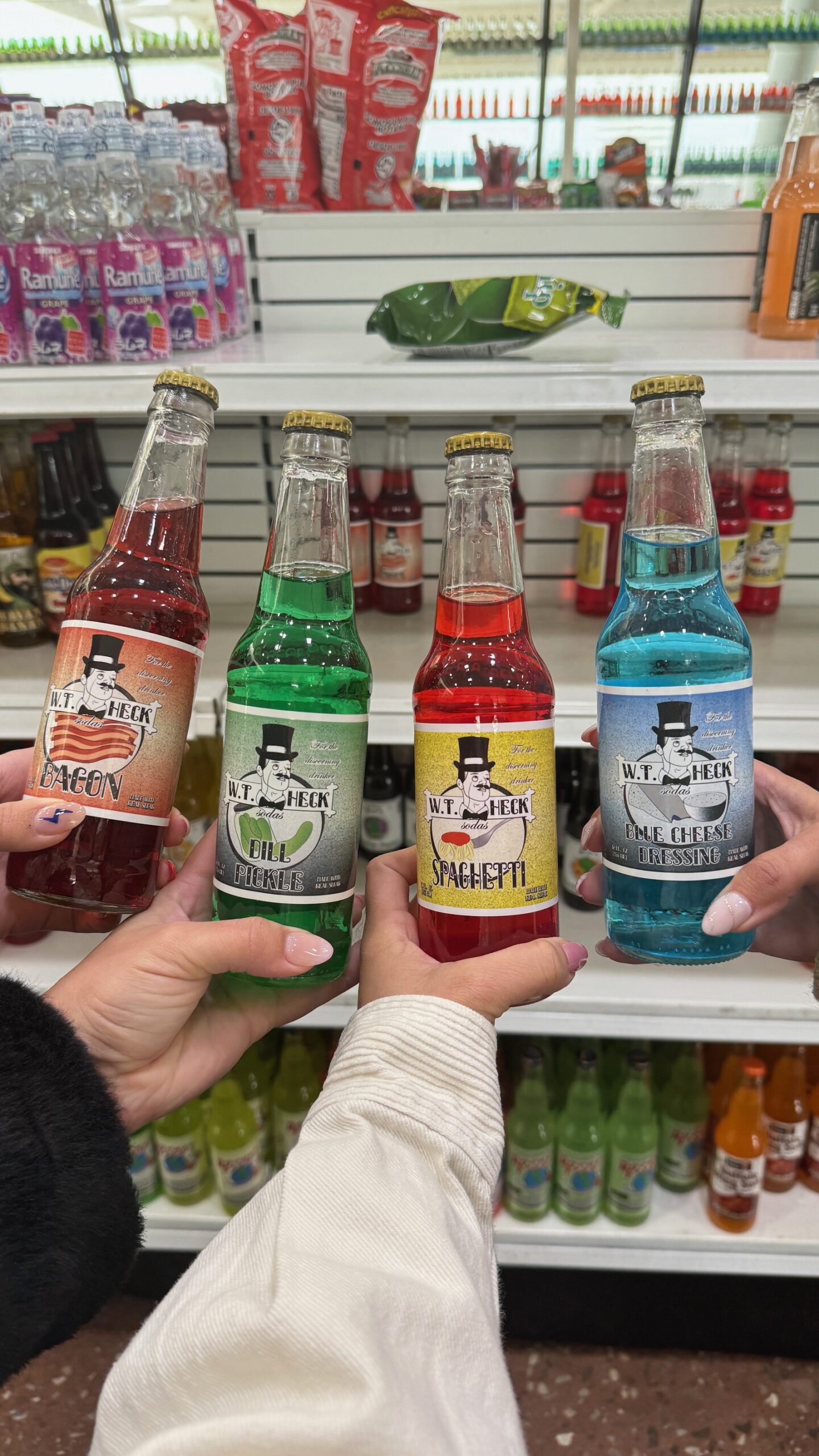
Pops 66
Our accommodation in: Honcho RV Park in Tulsa
Historic motels on the state: Sleepy Hollow Motel in Tulsa, Wagon Wheel Motel in Miami.
Angel’s tip: Please be aware of the weather, as some states you pass like this one are on the tornado Alley. Tornadoes can occur in many states across the United States, but some states are more prone to experiencing them than others. The states commonly known as part of the “Tornado Alley” are typically the most susceptible to tornado activity. These states include: Texas, Oklahoma and Kansas that are often considered the heart of the Tornado Alley, Nebraska, Iowa, South Dakota, Missouri, and Illinois.
5th state: TEXAS
While Texas has a relatively small stretch of Route 66 compared to other states, there are still several attractions and experiences worth exploring along the route. Whether you’re interested in history, culture, or outdoor adventure, Texas has something to offer every traveler on the Mother Road and it is so authentic and vibey! We loved it!
Capital: Austin
Sightseeings:
- Drive the Route 66 Historic District in Clinton and enjoy vintage signs, buildings, and landmarks that harken back to the heyday of the Mother Road.
- U-Drop Inn or Tower Station and Café in Shamrock, a popular stopping point for travelers along Route 66 and a visitor center and museum.
- Sixth Street Historic District in Amarillo, is known for its historic buildings, shops, restaurants, and nightlife.
- Palo Duro Canyon State Park near Amarillo, the second-largest canyon in the United States. If you have time, go for a hike and enjoy some amazing views of Texas!
- Cadillac Ranch near Amarillo, Texas, a quirky roadside attraction featuring a row of half-buried Cadillac cars covered in graffiti. Angel’s tip: Visitors are encouraged to bring spray paint and contribute to the ever-changing artwork. I bought one there for 7.5 euros.

- Milburn-Price Culture Museum in Vega, a fun local museum with interactive things to do.
- Midpoint cafe and gift shop in Adrian is a must stop situated at the midpoint of Route 66 between Chicago and Santa Monica in California.
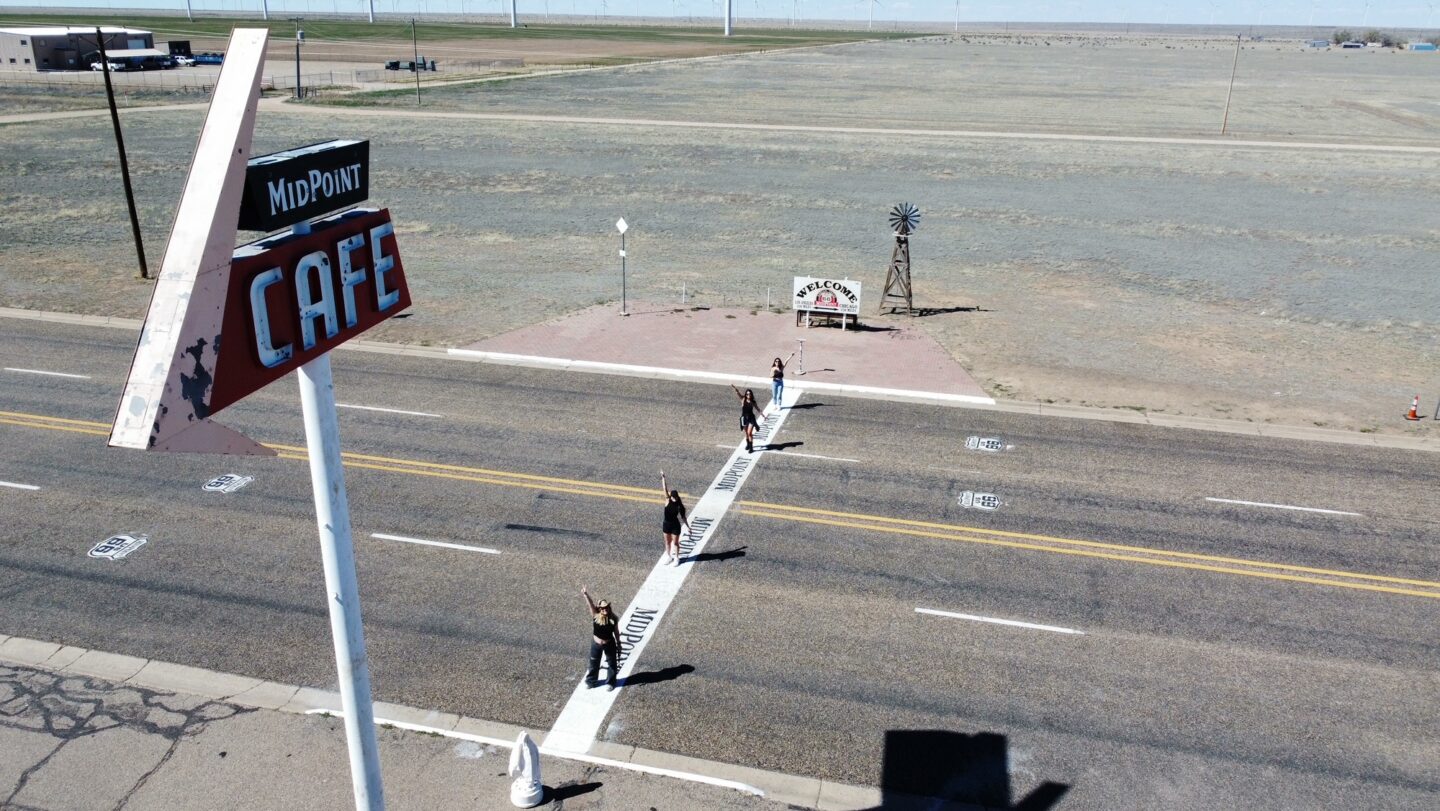
Food stops: Ye Olde Pancake Station for delicious breakfast in Amarillo, Big Texan Steak Ranch in Amarillo known for its Texas-sized steaks & entertaining atmosphere.
Angel’s tip: You can challenge yourself or just see others trying to finish the 72-ounce (2 kg) steak dinner in under an hour for a chance to win a prize and eat for free; otherwise you pay $250
Our accommodation in: Big Texan RV Ranch
Historic motels on the state: Big Texan Motel in Amarillo, Route 66 Inn in Shamrock
06th state: NEW MEXICO
New Mexico is known for its stunning natural landscapes, rich cultural heritage, and vibrant artistic communities, making it a unique and beautiful state to explore. A great destination for travelers seeking an authentic and memorable experience in the heart of the US!
Capital: Santa Fe

Santa Fe is sooo beautiful!
Sightseeings
- Endee ghost town.
- Tucumcari town with the beautiful historic motels, souvenirs shops like the Tee Pee Curios and the Dinosaur Museum.
- Santa Fe, an iconic destination along the historic highway that you cannot miss!! I adored it! It has a wonderful architecture, a thriving arts scene, numerous galleries and the oldest church in the USA (San Miguel’s). Stroll through its charming downtown that evoke the essence of the Old West and immerse yourself in the city’s rich cultural heritage.
- Albuquerque city with its vibrant downtown, diverse neighborhoods, and bustling arts scene. The famous TV series “Breaking bad” was filmed here. Outside of the city, you can visit the “Sandia Peak Tramway”, an aerial tramway with great views. Angel’s tip: If you are there during October, don’t miss the world-famous Albuquerque International Balloon Fiesta.
- Gallup, a beautiful town with murals and full of Native Americans. In the Gallup Cultural Center, you can learn about Native American art, history, and culture through exhibits, demonstrations, and events. Close by you can admire the Red Rock Park.
Angel’s tip: Did you know that the influence of Mexican cuisine in certain parts of the United States that share a border with Mexico, such as California, Arizona, New Mexico, and Texas, is intense? New Mexico is known for its unique cuisine, which blends Native American, Mexican, and Anglo culinary traditions.
Food stops: Jerry’s cafe in Gallup for breakfast, Route 66 Diner in Albuquerque, Pow Wow Restaurant & Lizard Lounge, the Kix on 66 Diner, Del’s restaurant for Mexican cuisine in Tucumcari, Tumbleroot Pottery Pub for unique cocktails in Santa fe, Earl’s Family Restaurant in Gallup

Route 66 Diner in Albuquerque
Our accommodation: Blue Shallow Motel in Tucumcari for 1 night and Enchanted Trails RV Park & Trading Post in Albuquerque for 1 night.
Angel’s tip: While we had the RV where you could sleep at night, we wanted to feel the experience of a historic motel. That’s why we chose the iconic Blue Swallow Motel.They welcome travelers since 1939 and I strongly recommend you to book there for at least 1 night to experience the nostalgia of Route 66 hospitality and sleep in a vintage room with modern amenities.
Angel’s tip: If you want to stay in an RV Park in Tucumcari, you can choose the Blaze-in-Saddle RV Park.
Historic motels on the state: Blue Shallow Motel, Motel Safari and Roadrunner Lodge in Tucumcari, Sunset hotel in Moriarty.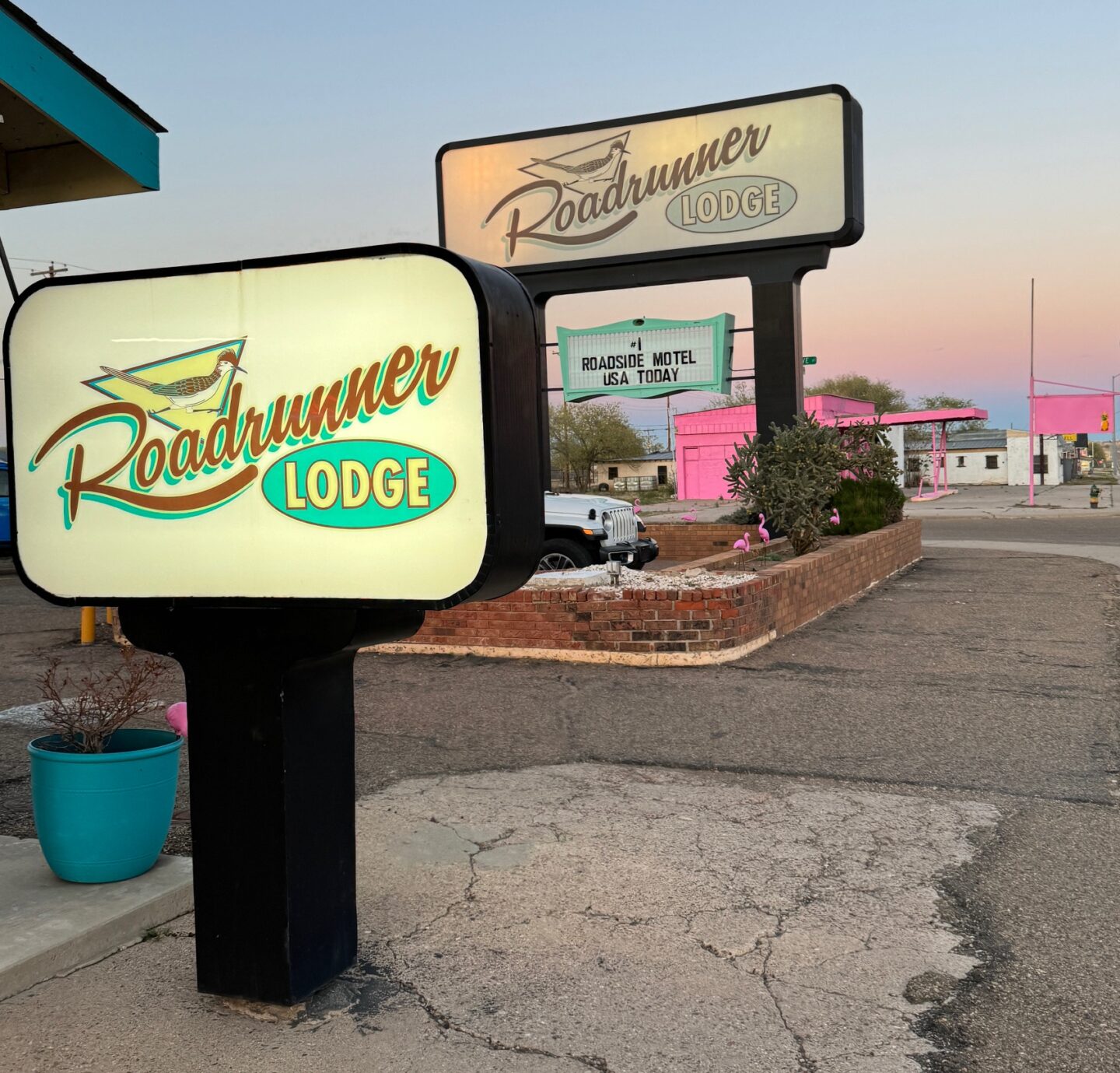
07th state: ARIZONA
Arizona is a beautiful and diverse state with stunning landscapes, iconic landmarks and abundant opportunities for outdoor adventure! It has usually warm and sunny climate for most of the year, making it an ideal destination for outdoor activities and winter escapes! From the majestic Grand Canyon to the otherworldly rock formations of Monument Valley, Arizona is home to some of the most breathtaking landscapes in the United States. Visitors can explore desert landscapes, towering mountains, and lush forests, all within the state’s borders.
Capital: Phoenix
Sightseeings:
- Petrified Forest National Park, home to colorful petrified wood, ancient petroglyphs, and stunning badlands vistas. Don’t miss the Painted Desert overlooks for panoramic views.
- Jack Rabbit Trading Post for souvenirs, gifts, and Native American crafts.
- Winslow town: visit the home of the iconic Eagles song “Take It Easy” , the life-sized bronze statue and explore the Route 66-themed murals and souvenir shops.

- Meteor Crater: one of the best-preserved meteorite impact sites on Earth at Meteor Crater near Winslow. Take a guided tour to learn about the crater’s formation and impact on the surrounding landscape, the documentary we saw was great too! Angel’s tip: A very small deviation from Route 66.
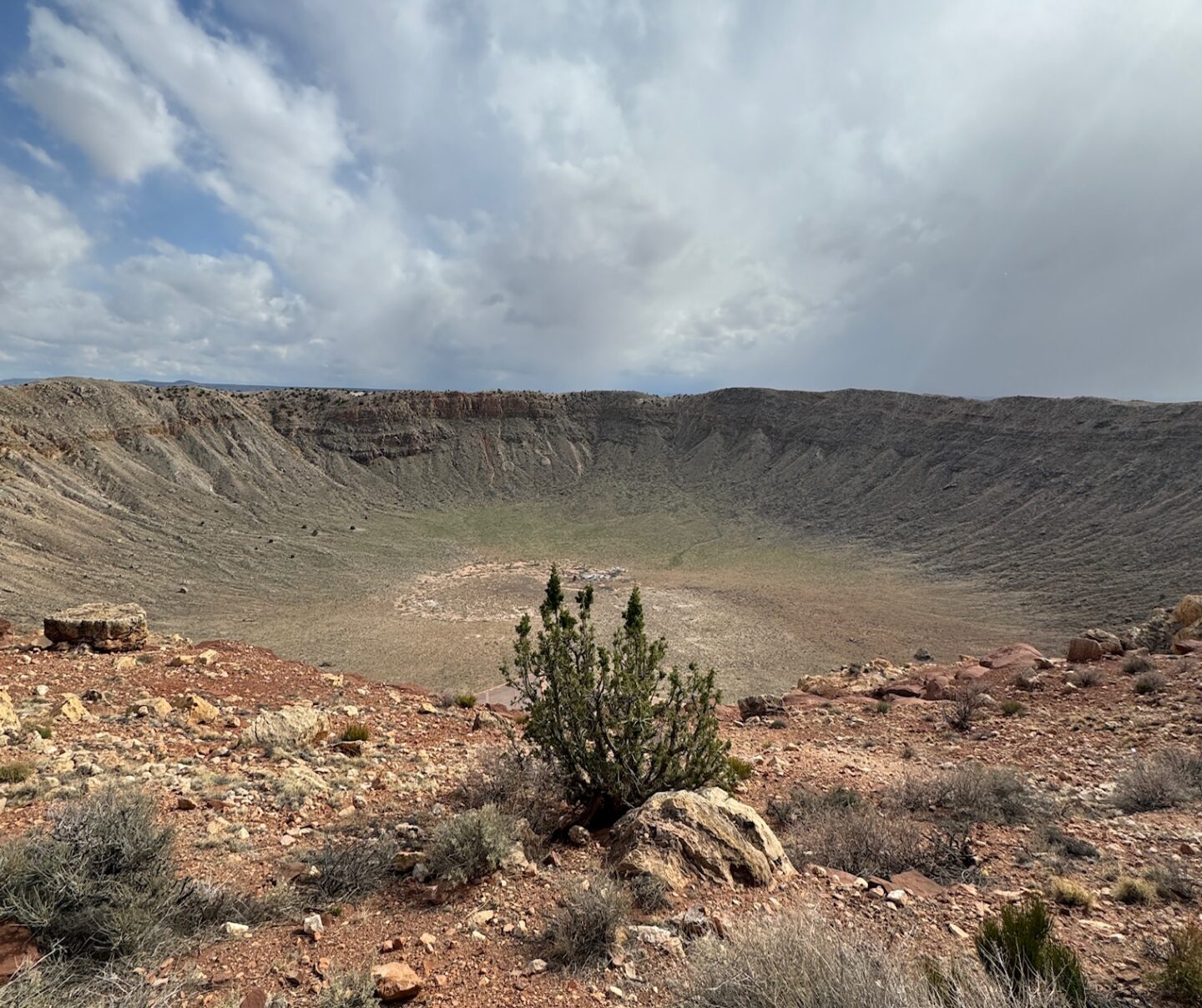
- Flagstaff charming town with the wonderful murals and shops. Don’t miss to stroll around old town and try beers in the local breweries housed in historic buildings. Angel’s tip: A great brewery is Mother Road Brewing Company.
- Williams, one of the last remaining towns along the historic Route 66 .You can stroll along the nostalgic Route 66 district downtown, lined with vintage motels, diners, and gift shops. Angel’s tip: for some fun, visit the Canyon coaster for $20 pp and a short but cool ride.
- Seligman town, known as the “Birthplace of Historic Route 66” is often cited as one of the inspirations for the fictional town of Radiator Springs in the Pixar animated film “Cars.” The film’s creators drew inspiration from various real-life locations along Route 66, and Seligman is one of the towns that influenced the look and feel of Radiator Springs. Stroll around the town’s vintage signs, cars, neon lights, and kitschy roadside attractions, including the Snow Cap Drive-In and the Roadkill Cafe. Angel’s tip: You can find many souvenir shops in Seligman and the must try milkshakes in “Delgadillo’s Snow Cap”.
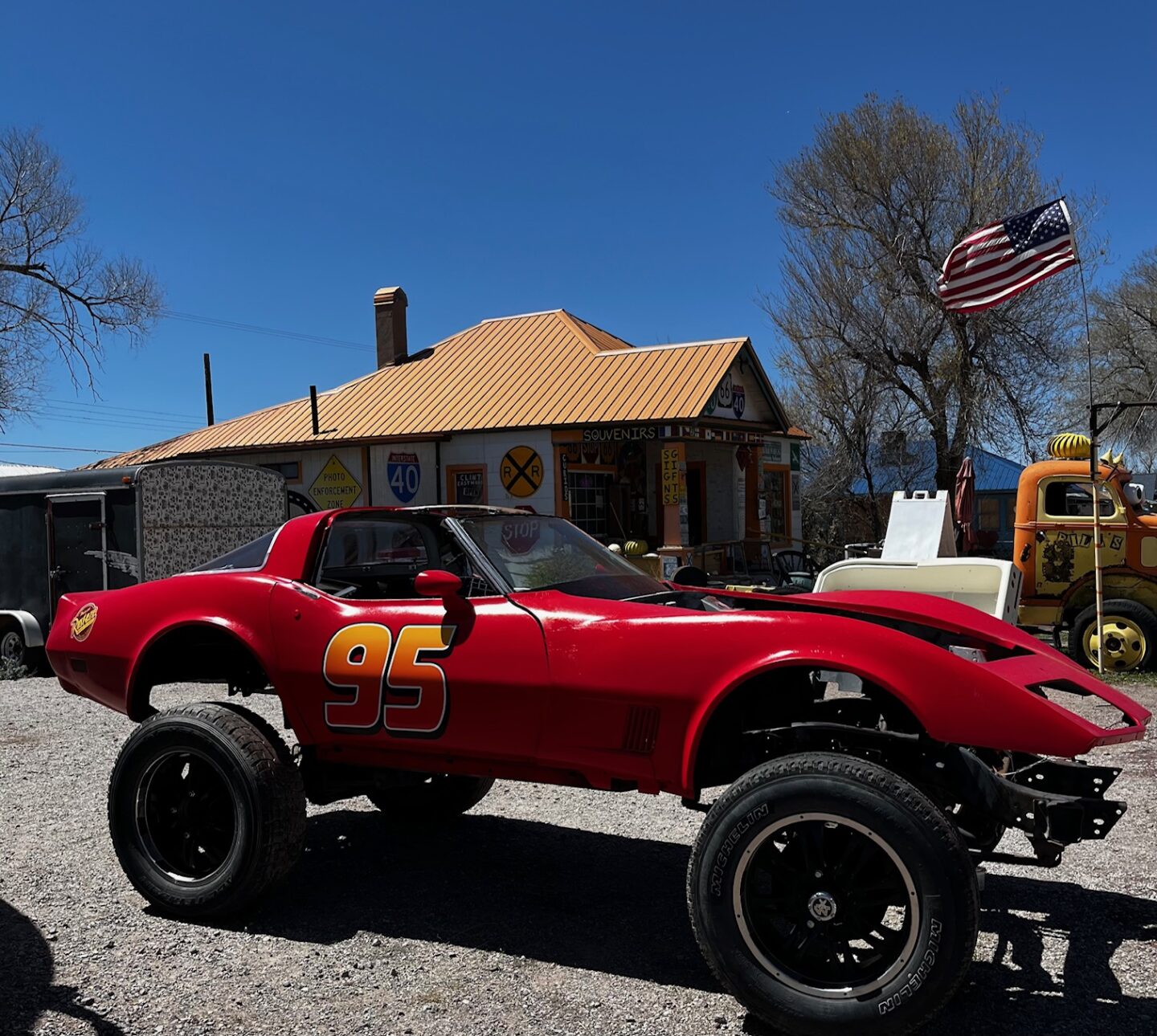
- Grand Canyon Caverns, one of the largest dry caverns in the United States. Take a guided tour to explore the underground chambers and learn about the caverns’ geology and history. Angel’s tip: The restaurant there is so impressive.
- Kingman village & Route 66 museum.
- Oatman a charming old mining town where you feel like you step back in time to the Wild West. Watch old-fashioned gunfights, and explore the town’s shops, saloons, and museums.

Food stops: Proper Meats + Provisions for homemade meat sandwiches in Flagstaff, Mr. D’z Route 66 Diner in Kingman, Delgadillo’s Snow Cap in Seligman, Roadkill Cafe in Seligman, Grand Canyon Caverns Underground Suite in Peach Springs for a gourmet meal surrounded by ancient cavern formations.
Our accommodation: a Super 8 hotel for 2 nights in Flagstaff , Yapapai Lodge in Grand Canyon for 2 nights.
Historic motels on the state: Wigwam Motel in Holbrook, Stagecoach 66 Motel in Seligman, El Trovatore motel in Kingman.
MUST DO deviations:
-Sedona, 1 hour drive from Flagstaff.
Sedona is a picturesque town located in the northern region of Arizona, renowned for its stunning natural beauty, vibrant arts community, and spiritual energy. Sedona is famous for its breathtaking red rock formations, which are sculpted by millions of years of erosion and abundant opportunities for outdoor recreation amidst its stunning landscapes. You can hike along scenic trails, go mountain biking, rock climbing, horseback riding, and enjoy jeep tours to explore the rugged terrain and panoramic vistas.
Sedona offers a plethora of hiking options amidst its stunning red rock landscapes. Here are some popular hiking trails in Sedona: Cathedral Rock Trail (we did it), Devil’s Bridge Trail, Bell Rock Pathway, West Fork Trail, Soldiers Pass Trail, Airport Mesa Loop Trail, Fay Canyon Trail…
Angel’s tip: We had booked in advance a pink jeep tour as well (duration 2 hours) for 150 euros pp and it was amazing! We chose The Broken Arrow tour. Check more here.

-Antelope Canyon is one of the most incredible places I have ever visited! Its mesmerizing beauty is due to the unique combination of natural forces that have shaped its sandstone walls over millions of years. The canyon’s narrow passageways, smooth curves, and vibrant colors create a surreal and otherworldly atmosphere that captivates visitors from around the world.
Antelope Canyon holds cultural significance for the Navajo people, who consider it a sacred place. Many tour operators are owned and operated by Navajo guides who share their knowledge of the canyon’s history, geology, and cultural significance with visitors. So, you cannot visit alone, everyone must join a guided tour led by Navajo guides. Angel’s tip: We booked a day tour (with the company Grand Canyon adventures via VIATOR) departing from Flagstaff to both Antelope Canyon and Horseshoe Bend. The cost with snacks, the entrances, the tour guides and all transportation included was 250 euros each. There are many tour guides online that you can check and hope you will find something cheaper! It was expensive but we didn’t have to drive and the tour was fantastic so I recommend them!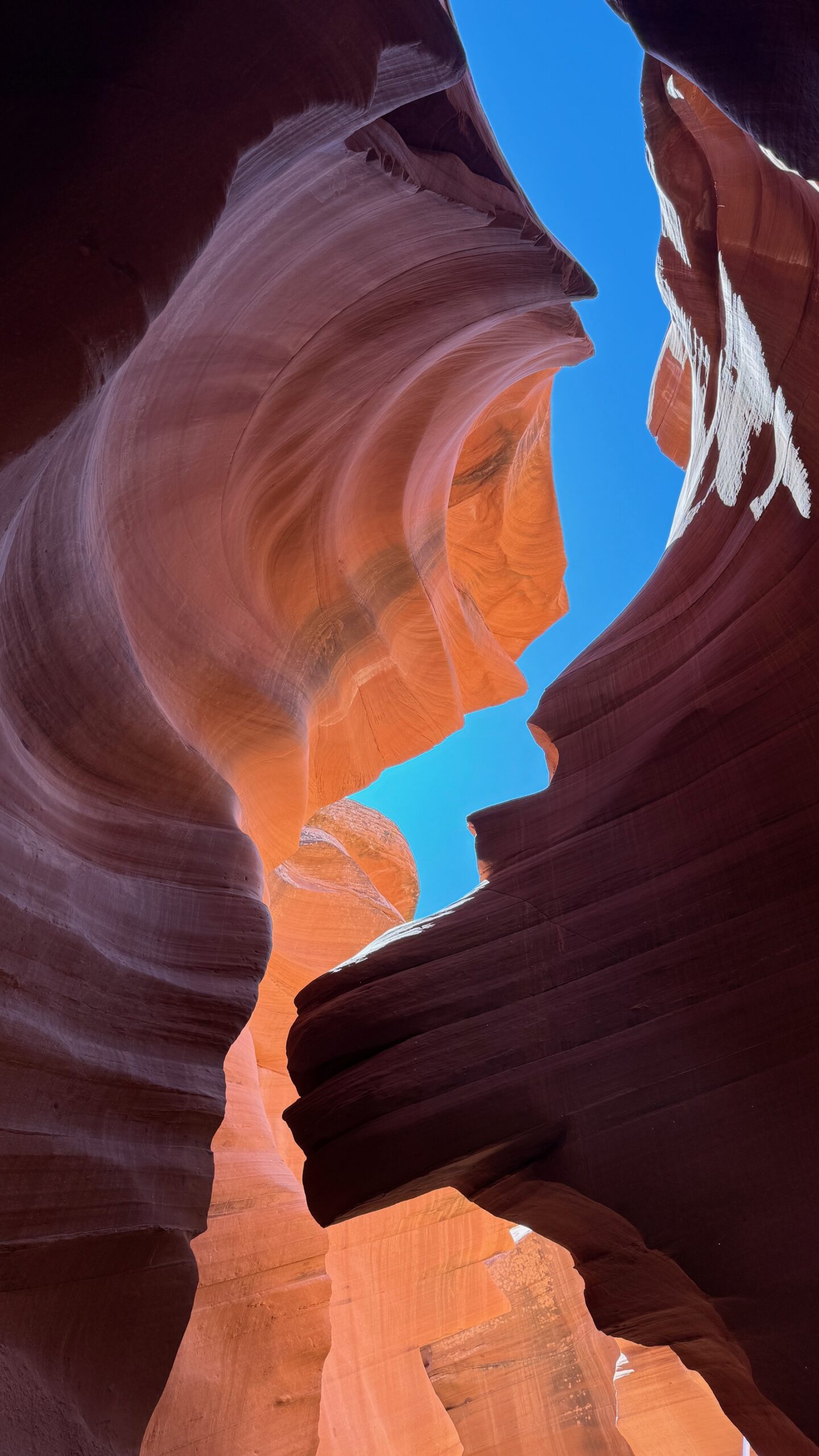
-Horseshoe Bend, a horseshoe-shaped bend in the Colorado River in Page in Arizona, carved over millions of years by the erosive forces of water and sediment. The meander is characterized by steep cliffs and a sharp curve, creating a dramatic and picturesque landscape. The main attraction at Horseshoe Bend is the scenic overlook that offers panoramic views of the meander and the surrounding canyon landscape. From the parking area, we walked 10-15 minutes to the view point, as per the picture below but please be careful as it is dangerous standing close to the edge.
-Grand Canyon, one of the largest and most iconic canyons on Earth that was carved by the Colorado River over millions of years. It stretches for approximately 446 kilometers (277 miles) reaches depths of over a mile (1.6 kilometers), and spans widths of up to 18 miles (29 kilometers). It is renowned for its breathtaking vistas, colorful rock formations, and dramatic landscapes. The Grand Canyon is divided into 2 main sections: the South Rim and the North Rim. The South Rim is the most visited and accessible part of the canyon, offering iconic viewpoints such as Mather Point, Yavapai Point, and Desert View. The North Rim, while less visited, provides a more remote and rugged experience with fewer crowds and different perspectives of the canyon. Angel’s tip: While most of the visitors just admire it from view points, I totally recommend you to hike through it for a bit.
Here are some popular hikes in the Grand Canyon: Bright Angel Trail, South Kaibab Trail, North Kaibab Trail, Grandview trail and of course the famous and bucketlist hike: Rim-to-Rim for ambitious hikers looking for a multi-day adventure. This is is hiking from the North Rim to the South Rim (or vice versa) via the Rim-to-Rim trail but careful planning and preparation is required, as it covers approximately 21 miles (34 kilometers) and involves significant elevation gain and loss. If we had time, I would love to do it with an overnight stay in between.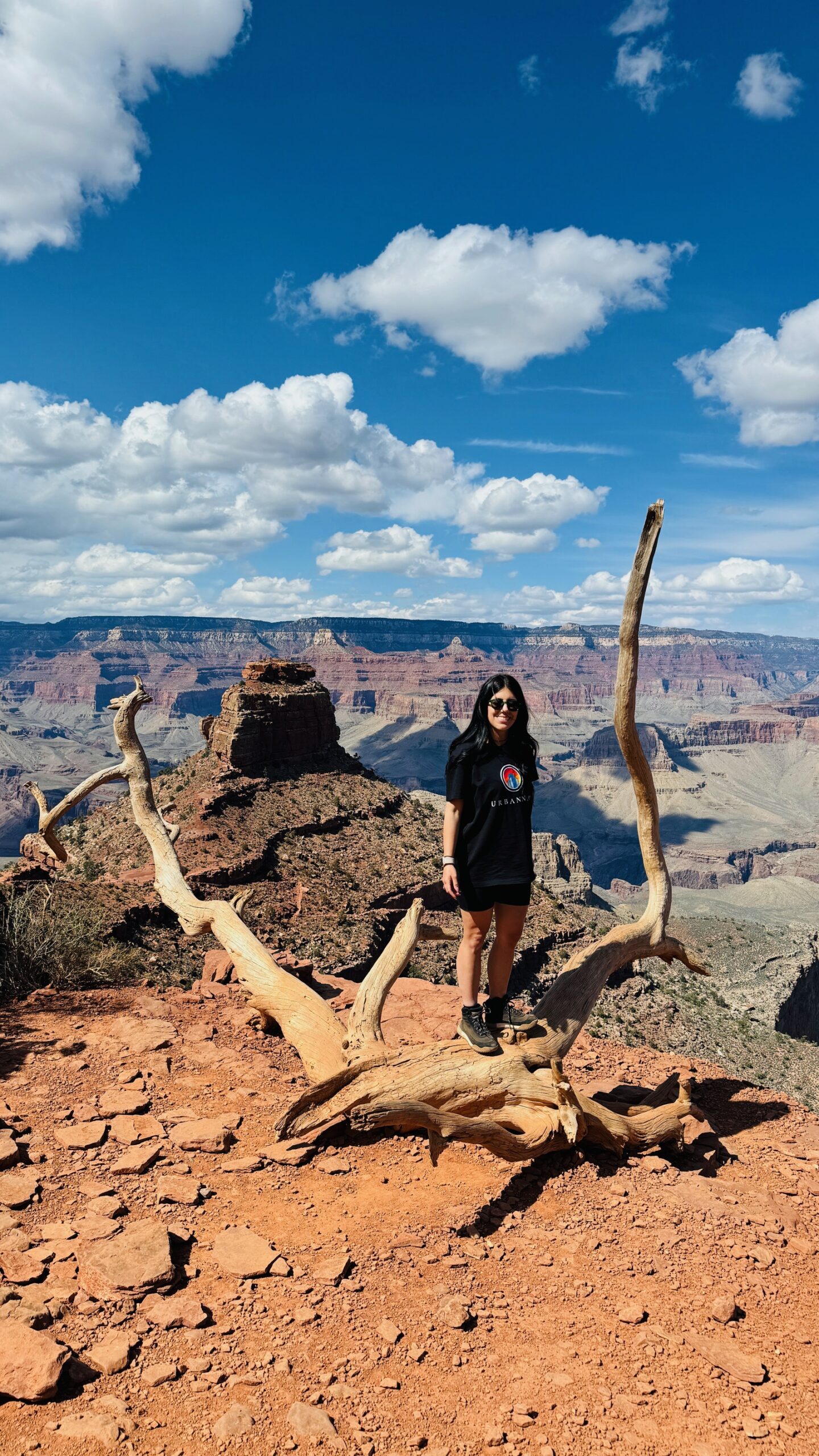
-Monument Valley, a breathtakingly beautiful and iconic destination located on the Arizona-Utah border in the southwestern United States. It is renowned for its stunning red sandstone formations, towering buttes, and vast desert landscapes. The area has been featured in numerous films, television shows, and advertisements, making it one of the most recognizable landscapes in the world. Visitors can explore the park’s scenic drives, hiking trails, and viewpoints while learning about the area’s rich Native American history, culture, and traditions. The 17-mile (27-kilometer) scenic drive through Monument Valley offers breathtaking views of iconic rock formations such as the Mittens, Merrick Butte, and Three Sisters. It is part of the Navajo Nation as well.
Angel’s tip: Did you know that there are Native American nations in the USA (tribes) that are recognized as sovereign by the US government and have a degree of self-governance? Examples are the Navajo Nation, Cherokee, Choctaw etc! They have their own governments, time zone, laws & cultural practices. How cool is that?
-Havasu Falls, a stunningly beautiful waterfall located within the Havasupai Indian (Native American) Reservation in a remote and rugged area of the Grand Canyon that is accessible only by hiking or horseback riding. Havasu Falls is renowned for its breathtaking turquoise-blue waters, which cascade over travertine rock formations into a series of vibrant turquoise pools below. The contrast between the vivid blue water and the red rock canyon walls creates a stunningly beautiful and otherworldly landscape. Due to its remote location, reaching Havasu Falls requires a challenging hike of approximately 10 miles (16 kilometers) each way from the trailhead at Hualapai Hilltop. The trail descends into the canyon and traverses rugged terrain, including steep switchbacks and rocky paths. Visitors can also arrange to travel to the falls by horseback riding or helicopter. Visiting Havasu Falls requires obtaining a permit from the Havasupai Tribe, as well as making reservations for camping or lodging within the reservation. Permits are limited and in high demand, particularly during peak season, so it’s essential to plan and book well in advance. Angel’s tip: We didn’t do it, as it is quite demanding, so please be sure you have arranged everything before you give it a try!
Extra state: NEVADA –> deviation from Route 66
You can read more in my separate article for Las Vegas (which is coming up soon).
08th state: CALIFORNIA
As you approach the end of the Route 66 in Santa Monica in Los Angeles, you’ll encounter fewer iconic Route 66 attractions compared to other sections of the route. However, there are still some sights and landmarks to see like the ones below:
Capital: Sacramento
Sightseeings:
- Roy’s Motel and Café in Amboy, a classic Route 66 landmark with its iconic neon sign and mid-century architecture. The motel is no longer in operation but you can grab a snack or buy souvenir from the café.

- Route 66 Museum in Barstow
- Calico Ghost town, a historic mining town located in the Calico Mountains of the Mojave Desert founded in 1881 that quickly grew into a bustling mining town, producing over $20 million in silver ore over a 12-year period. However, by the early 1900s, the silver mines were depleted, and the town was abandoned. In the 1950s, Calico was restored and turned into a tourist attraction offering a glimpse into life in the Old West during the 1880s mining boom.

- Elmer’s Bottle Tree Ranch in Oro Grande, where you’ll find a whimsical and colorful collection of metal sculptures adorned with recycled glass bottles.
- First Original McDonald’s Museum in San Bernardino, a historic site that commemorates the founding of the first McDonald’s restaurant by Richard and Maurice McDonald in 1940. It’s not only a museum but also a replica of the original McDonald’s restaurant and Route 66 Roadside attraction.

- Cucamonga Service Station – a wonderful museum and visitor center, offering insights into the history of the area and the famous highway.
- Santa Monica Pier: The end of the Route 66 journey is at the Santa Monica Pier in Los Angeles. This historic pier features an iconic Ferris wheel, amusement rides, arcade games, restaurants, and shops, making it a fun and lively destination.
- And of course Los Angeles. Check more about LA in my separate post (which is coming up soon).
Food: Wagon Wheel Restaurant in Needles, Emma Jean’s Holland Burger Cafe in Victorville, Bagdad Café in Newberry Springs and of course numerous amazing restaurants in Los Angeles.
Our accommodation: Hayatt Hotel in Palm Springs , Indian Palms Vacation club (apartment booked through Airbnb) in Indio for Coachella musis festival, Hilton Santa Monica in Los Angeles and SLS Beverly Hills in LA
Angel’s tip: While the heart of Los Angeles is not directly on Route 66, we stayed for a few days and you can read more in my separate article (which is coming up soon).

HOW MUCH DID IT COST?
Embarking on this road trip was met with one of the most frequently asked questions, and I’m here to provide a breakdown of approximate costs to help you plan accordingly.
First things first, I began organizing and budgeting for this adventure about 10 months in advance. No travel agencies, just us, lots of research, reading, social media and our laptops! Let me tell you, investing in this road trip was one of the best gifts I’ve made to myself. Every single cent spent was well worth it! Angel’s tip: The currency used in the USA is the USD – United States Dollar. If you prefer seeing costs in your familiar currency, feel free to make the conversion.
The cost of traveling Route 66 can vary widely depending on factors such as the length of your trip, your mode of transportation, your accommodations, the number of people splitting the costs, dining preferences, and the activities you choose to participate in, along the way. We were 4 friends on this trip.
Angel’s tip: I will share everything below apart from Coachella with Palm Springs and San Diego as they were a deviation and the festival takes place only specific dates each year. I will write details about them in my other blog posts. I will put the costs of Grand Canyon, Antelope, Sedona & Las Vegas because I consider them as a must do on this trip!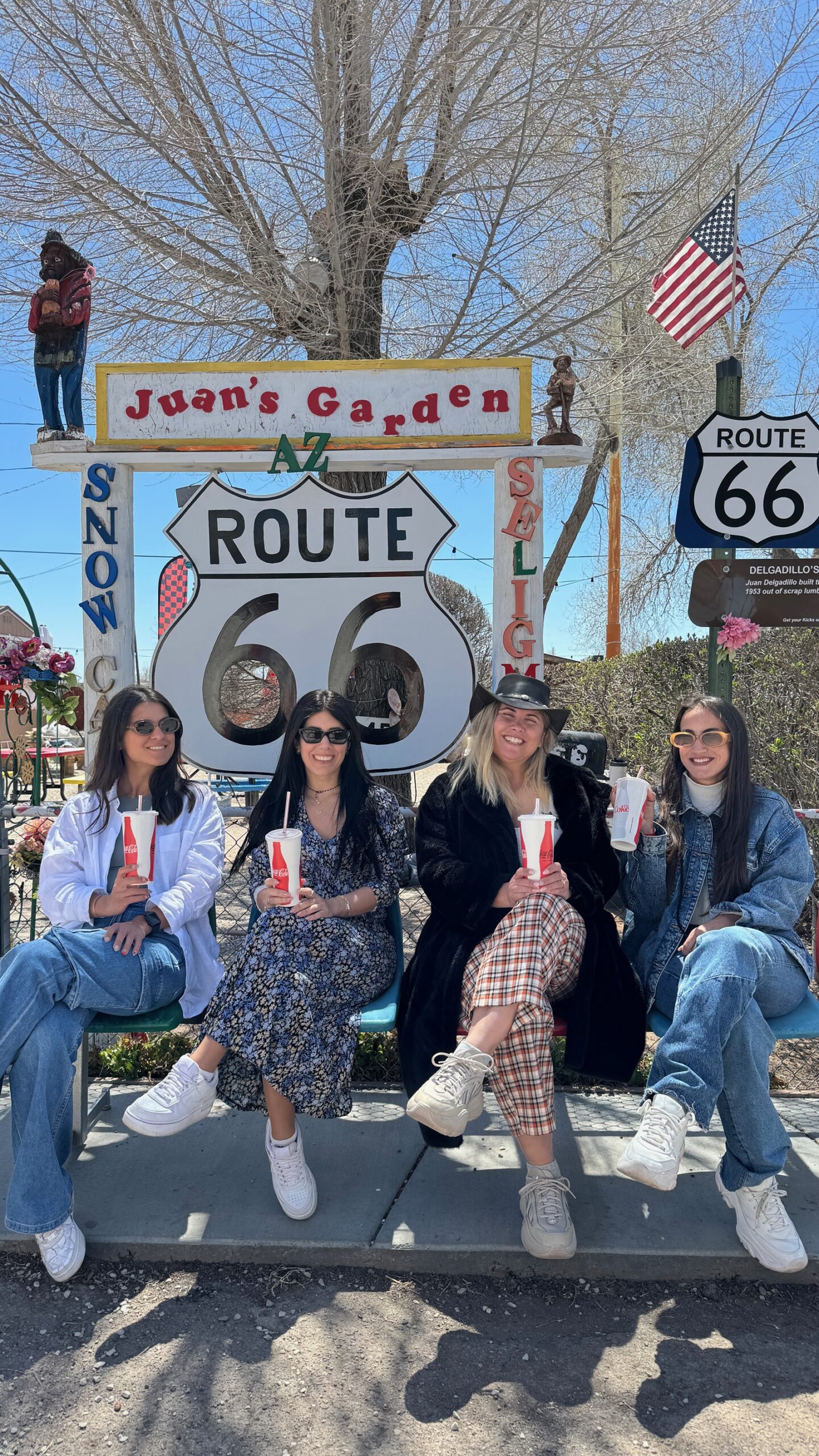
You can read more for Coachella in my separate article (which is coming up soon).
Below, I will share all of our expenses as accurately as I can:
Flights: We flew with Turkish Airlines from Athens to Chicago through Istanbul and from Los Angeles to Athens. If you are based in Greece, I totally recommend you doing the same. We paid €1100 each person round trip. (around $1180).
Transportation: RV + car rental(we made a deviation to switch in Phoenix): $1300 approximately per person
- The RV cost (we were 4 adults but it can also accommodate 2 kids) per day was $357 with very premium insurance(We could return it even in pieces!), travel kit, bedding kit, late drop off, delivery in a different state than the pick up and specific mileage included. The company was INDIE CAMPERS. Angel’s tip: the single cost of the RV was 126 usd per day but in the US with RVs sometimes you pay extra depending on the km/miles you drive (mileage). We calculated the distance we had to drive and we paid in advance the relevant amount per day. So the total payment for 9 nights everything included was $3213.
- We chose an SUV car with 7 seats (Chevrolet Suburban) since we had 10 suitcases and was a very smart thing to do, as you could drop the seats and increase the storage space! The cost for unlimited mileage was $157 per day. So for 12.5 days we paid $1956.

Gas: $700 for the RV and $420 for the car total. Per person: $280
Taxis: We used some taxis in Chicago (since we rented the RV exactly before the start of the roadtrip), in Las Vegas and Los Angeles to avoid the drive and the paid parking and be able to drink alcohol. Approximate total cost: 400 usd // $100 per person.
Angel’s tip: For example the taxi from downtown Chicago to the RV pick up point (that was a bit outside of the city) with 10 suitcases was $100.
Accommodation: While we had our RV, we stayed in RV parks with the full package (water, electricity, parking, Wi-Fi, bathrooms) , in one historic motel in Albuquerque and in various hotels when we had the car, as per below. For one person cost was $1230.
Below are the prices we paid per night, each room for 4 people or per RV, to have an idea: (total for all $4918)
- Chicago Hayatt for 2 nights: $230 per night for 4 people room
- Cooks RV Motor Park in Springfield Missouri for 1 night: $60 per RV
- Honcho RV Park in Tulsa OK for 1 night : $60 per RV
- Bug Texan RV Park for 1 night: $60 per RV
- Blue Swallow Motel for 1 night : $190 for 4 people room
- Enchanted Trails RV Park & Trading Post for 1 night: $40 per RV
- Super 8 in Flagstaff for 2 nights: $110 per night for 4 people room
- Yapapai Lodge in Grand Canyon for 2 nights: $529 per night for 4 people room
- The Cosmopolitan in Las Vegas for 2 nights: $580 per night for 4 people room (you can find much cheaper options but there was a mix up and we had to book a hotel on the spot)
- Hilton Santa Monica in Los Angeles for 2 nights: $380 per night for 4 people room
- SLS hotel Beverly Hills in los Angeles for 2 nights: $480 per night for 4 people room

Blue Swallow Motel in Tucumcari
Angel’s tip: In the hotels we chose to stay in Los Angeles, parking per night was $50-$70 (crazy!) but on the rest was free. (and in Chicago we didn’t have a car). Cost was $60 per person total.
Food and Dining: approximately $1360 per person
I tried to calculate for you the expenses for meals and dining out, along and before/after the roadtrip. You can save money by preparing your own meals or opting for affordable dining options , as we did sometimes, such as diners, roadside cafes, fast food like McDonald’s, Wendy’s, Pizza Hut, In-N-Out Burger and local eateries. Angel’s tip: Treat yourself to at least a few special meals at iconic Route 66 historic restaurants/diners and try regional specialties along the way. I mentioned some of them above in my description for each state.
We spent for food:
- In Chicago: $140 per person(pp) in restaurants
- Breakfast: $200 pp Angel’s tip: On average, the 4 of us were spending around $60-70 for a breakfast in a local restaurant.
- Supermarket: $100 per person
- Historic Diners on Route 66: $180 pp. Angel’s tip: The 4 of us were usually spending from $60 to $85 in local diners. Some exceptions were Big Texan that was around $50 pp and Del’s in Tucumcari that we spent $40pp.
- In Las Vegas: $100 pp
- In Los Angeles: $600 pp in good restaurants
- Fast food during the roadtrip: $35 pp
- Coffees: I don’t drink coffee but if you do, calculate at least $100 for take away coffees.

Attractions and Activities: around $840 per person
- Chicago Skydeck and Navy Pier Ferris Wheel: $60 pp (per person)
- Pink Jeep Tour in Sedona: $155 (plus $10 tip pp)
- Oklahoma museum: $7 pp
- Meteor Crater: $29 pp
- Antelope tour & Horseshoe Bend: $260 pp
- Sphere in LV: $100 pp
- Canyon Coaster Adventure Park in Williams: $80/4 people
- Universal Studios in LA: $140 pp
- Warner Bros Studios in LA: $70 pp

Canyon Coaster in Williams
Souvenirs and Shopping: The cost of souvenirs during a Route 66 trip can vary greatly depending on individual preferences, the number of souvenirs purchased, and their prices. Souvenirs can range from small items like keychains and postcards to larger items like T-shirts, hats, or local artisan crafts. As a rough estimate, I spent around $300 for gifts, shopping & souvenirs, but this can vary significantly depending on personal preferences and spending habits. Some travelers may choose to purchase only a few inexpensive souvenirs, while others may splurge on unique or high-quality items as mementos of their journey.
To have in mind, cost for fridge magnets was from $3.5 to $13, hats around $15-45 and small items like keychains, postcards, and stickers are usually inexpensive and can range from $1 to $10 USD each depending on the design and material. Angel’s tip: I regretted that I didn’t purchase my souvenirs in the first states that we passed by as they were less expensive on average and they had things I didn’t find later.
Miscellaneous Expenses: Don’t forget to budget for miscellaneous expenses such as parking fees, road trip supplies, entrance fees and any unexpected costs that may arise during your trip. Ours were around $100 per person.
- Route 66 Navigation application(an amazing app we downloaded in a mobile to find easily Route 66 and learn things): $40 for 1 year
- Sprays for Cadillac Runch: $15
- Grand Canyon Car fee entrance: $35
- Parking in Santa Fe: $20
- Casino in Las Vegas: $30 pp
- Calico Ghost town: $8 pp entrance fee
- Parking in Warner Bros & Universal studios: $50
- 4 Certificates as souvenir for the competion of Route 66 on Santa Monica Pier: $44
- Mother Road ROUTE 66 passport as souvenir (with details & stamps that you can collect in several stops along the route): $18
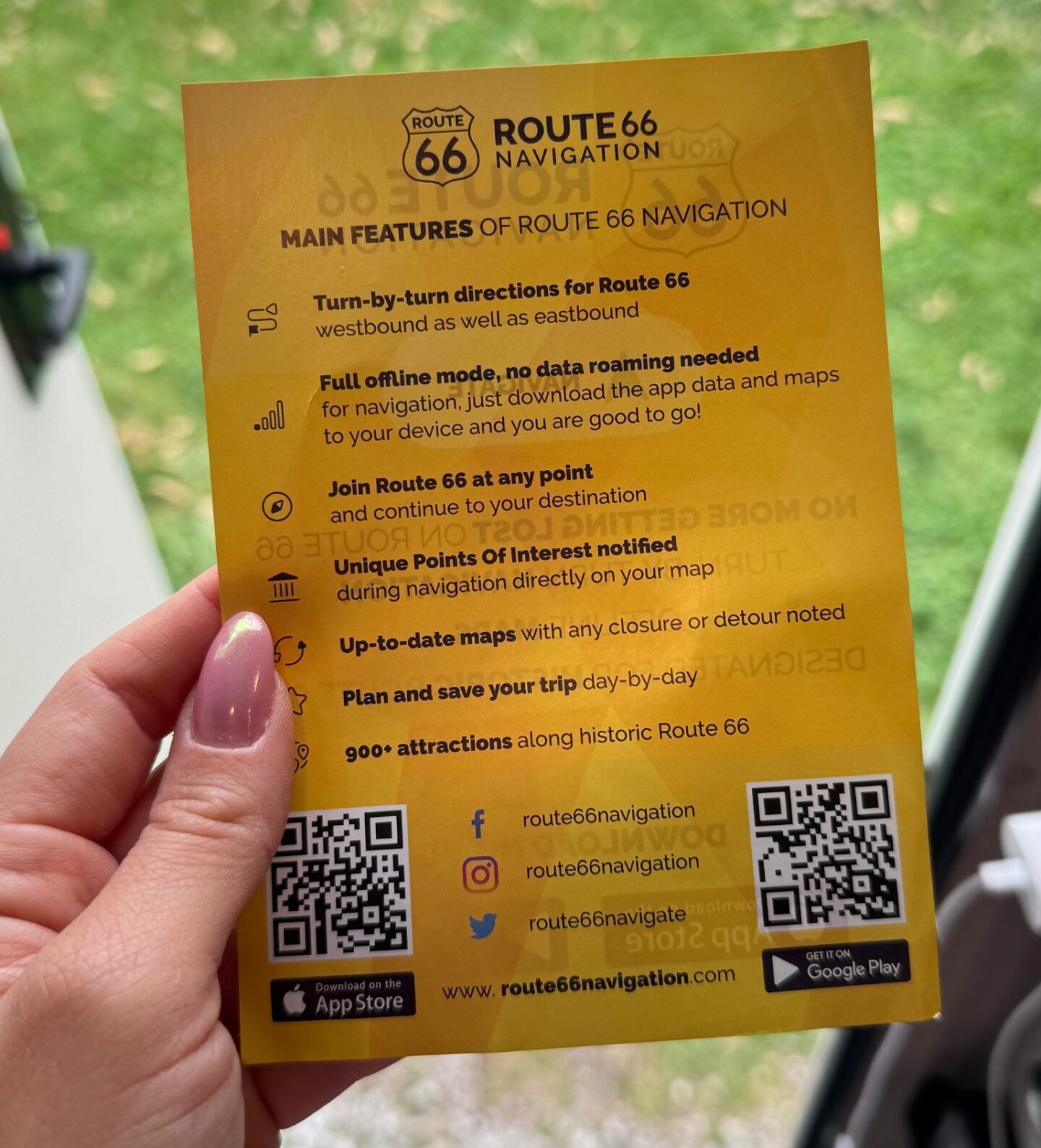
Tipping: Tipping is customary in the USA, and it’s important to factor gratuities into your budget when dining out, using transportation services, staying in hotels, or even in take-out! Tip amounts typically range around 20% of the total bill. The prices above include the tips.
TOTAL COST: Considering the Route 66 trip with detours to Las Vegas, the Grand Canyon, Antelope Canyon and Sedona, along with spending several days exploring both Los Angeles and Chicago(starting & ending points), the total cost comes to $6750 (€6300). However, it’s possible to lower this cost by opting for more budget-friendly hotels in major cities and dining at less expensive restaurants in Los Angeles!
Angel’s tip: As mentioned above and you have already seen on my Instagram account/highlights, my trip included Coachella too along with San Diego, Palm Springs and Joshua Tree – these costs have not been shared.
Coachella is an AMAZING annual music festival held in Indio in California USA, usually every April for 2 weekends. It’s one of the largest & most famous music festivals in the world, drawing attendees & celebrities from around the world with 10 stages & so many singers simultaneously. In case you are interested, check more in my separate article (which is coming up soon). The cost for this 3-day festival was $1600.
You can see more pictures in my highlights and post on Instagram
IG: angeliki.a_
Awesome guide! I did a similar route the same days (also stayed at the Super 8 in Flagstaff haha), but continued north after Vegas, and I can confirm my overall costs were very close as a solo traveller.
Thank you for putting down in writing what I only have as memories, photos and a few videos 😀
Author
Andrew!!! that’s amazing to hear!! Where did you go after Vegas?Loved every single day, it took me ages to create this blog post but i think it will be very useful for people that want to organize that:) not an easy trip!